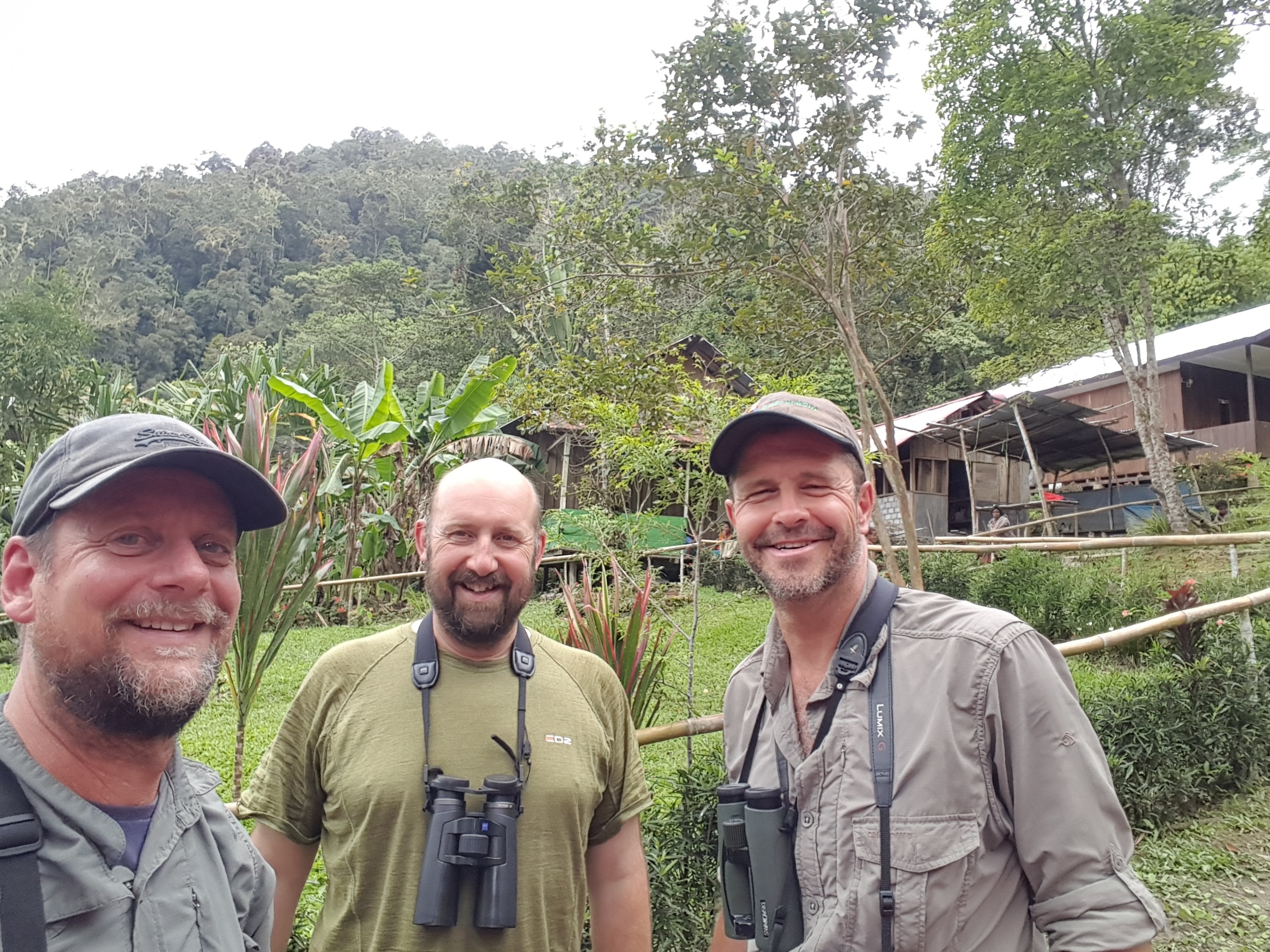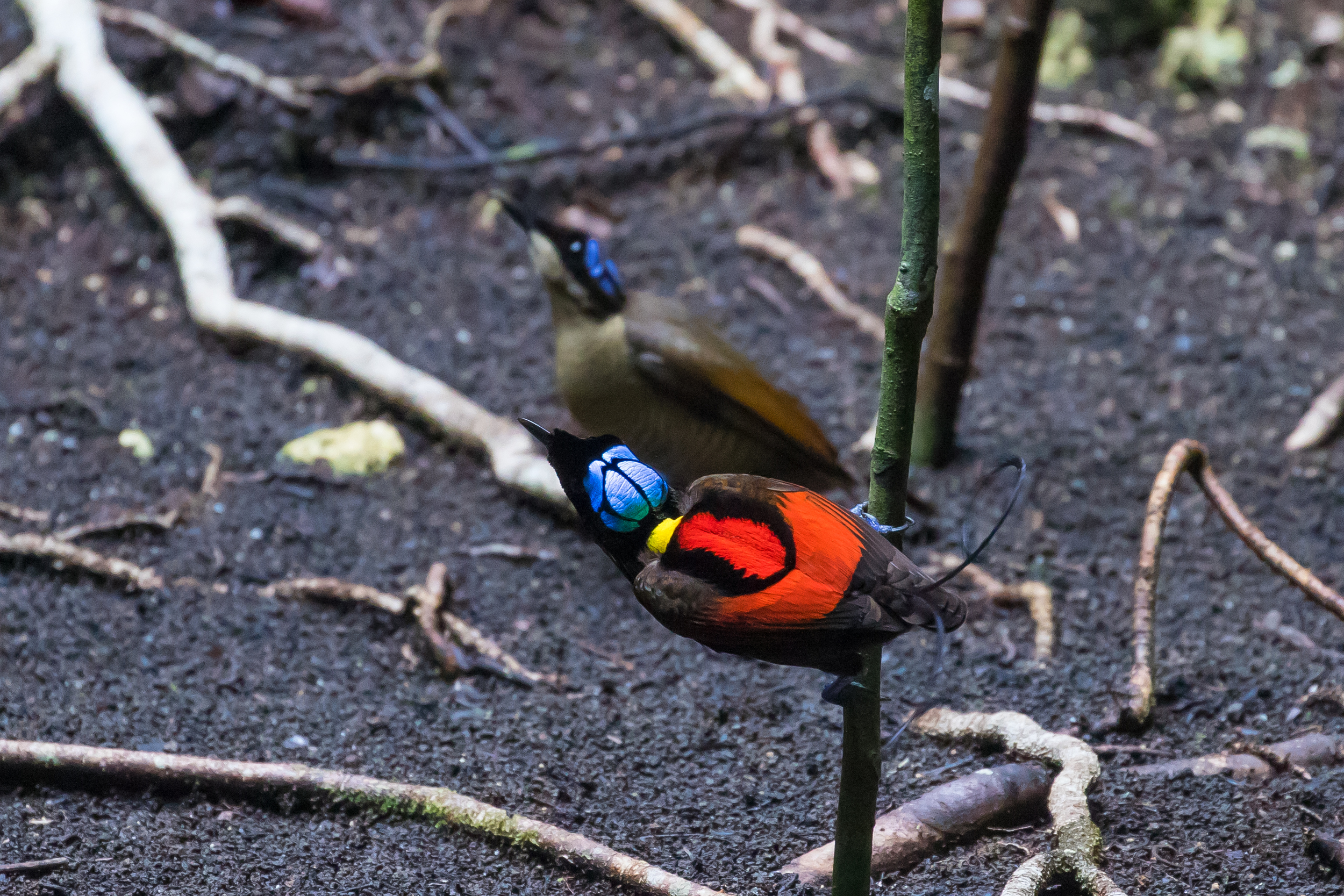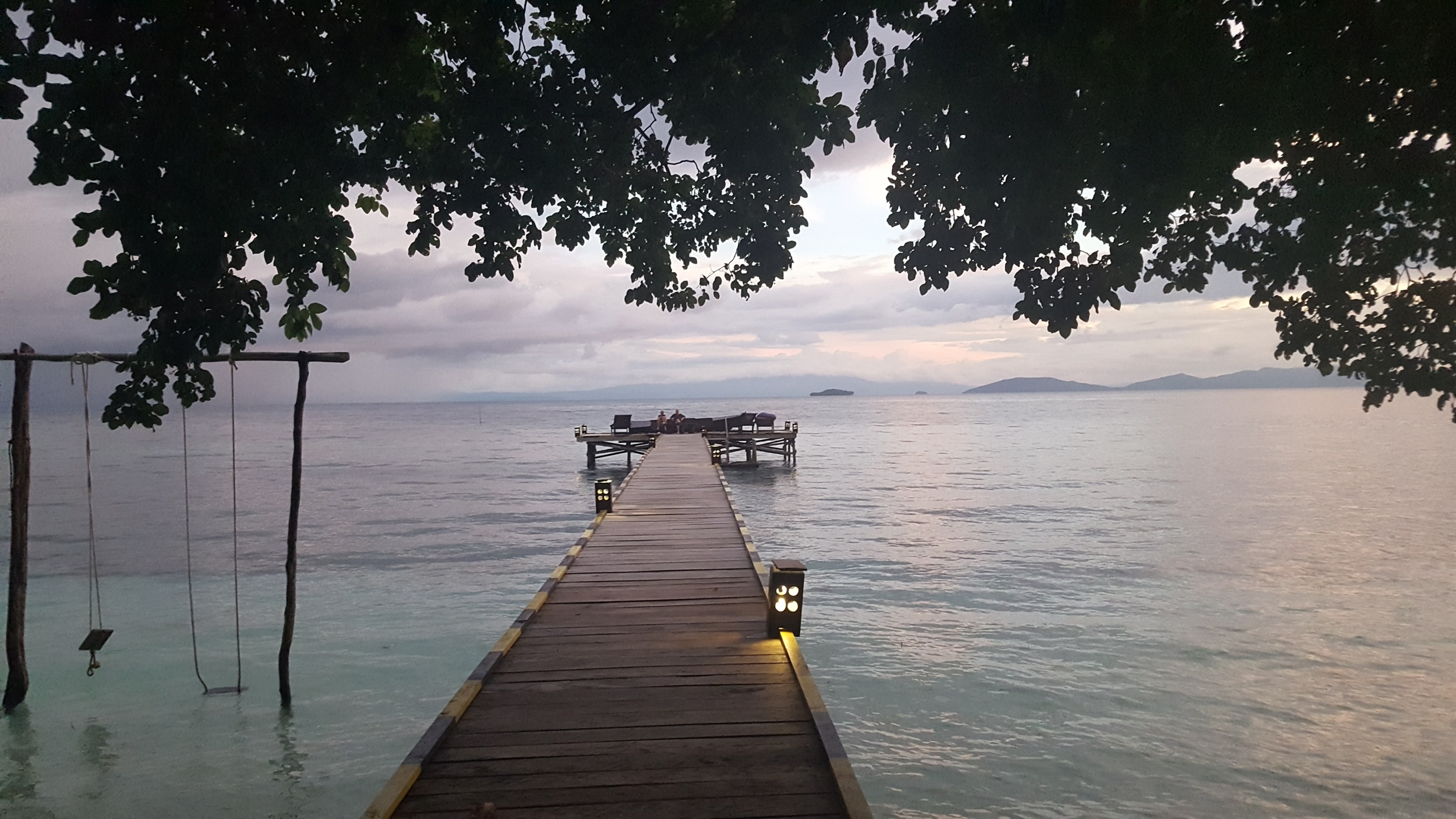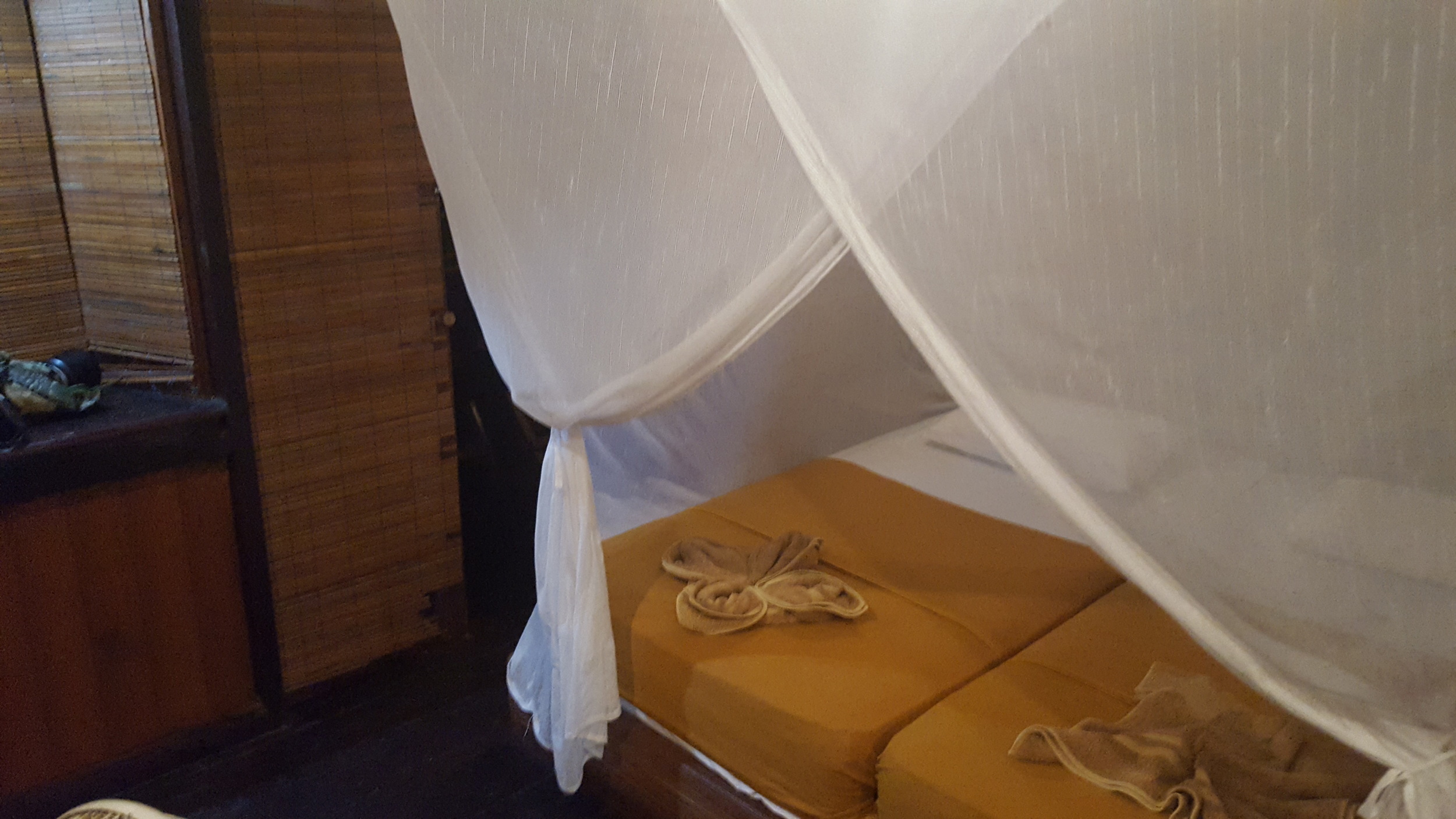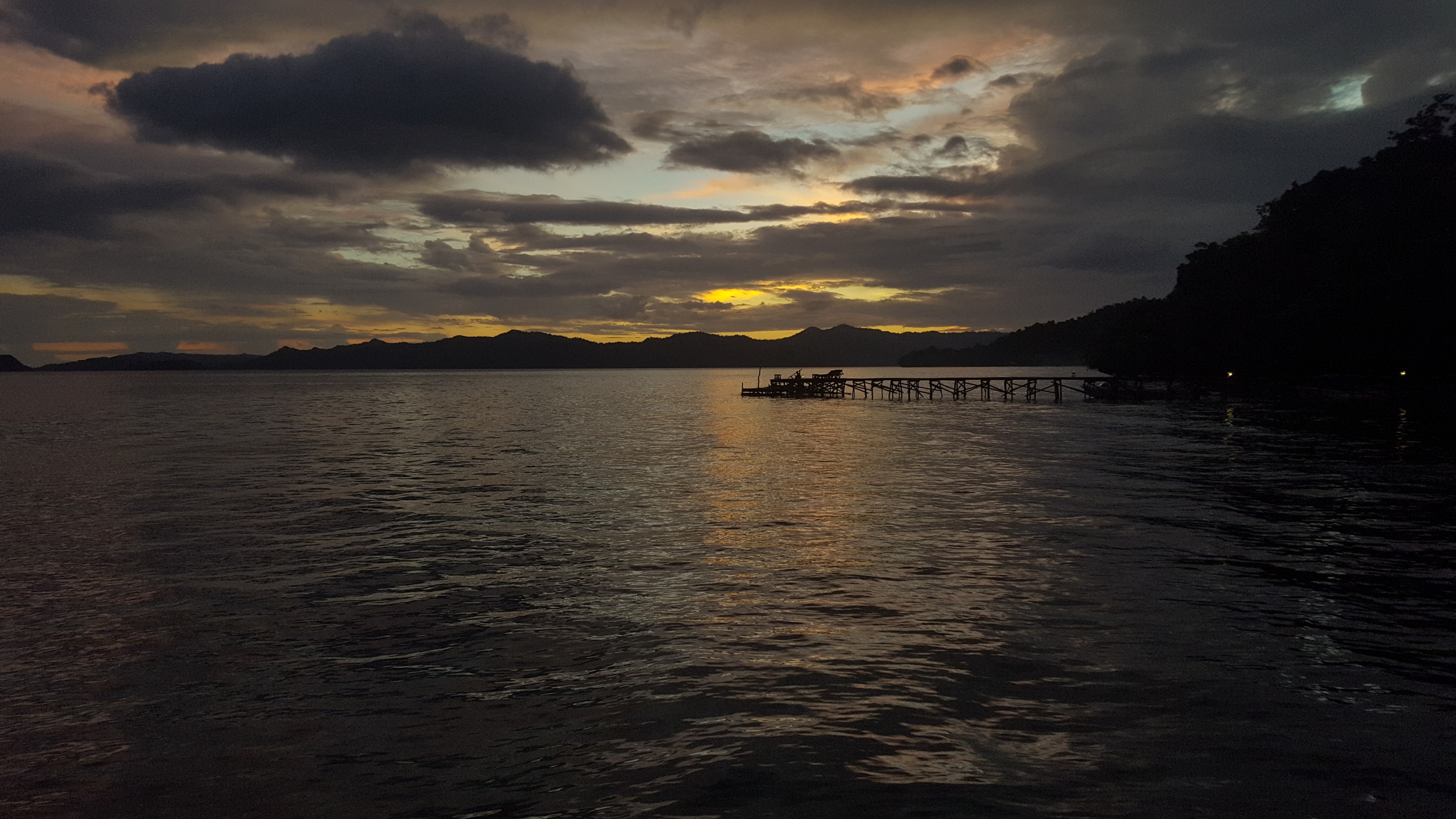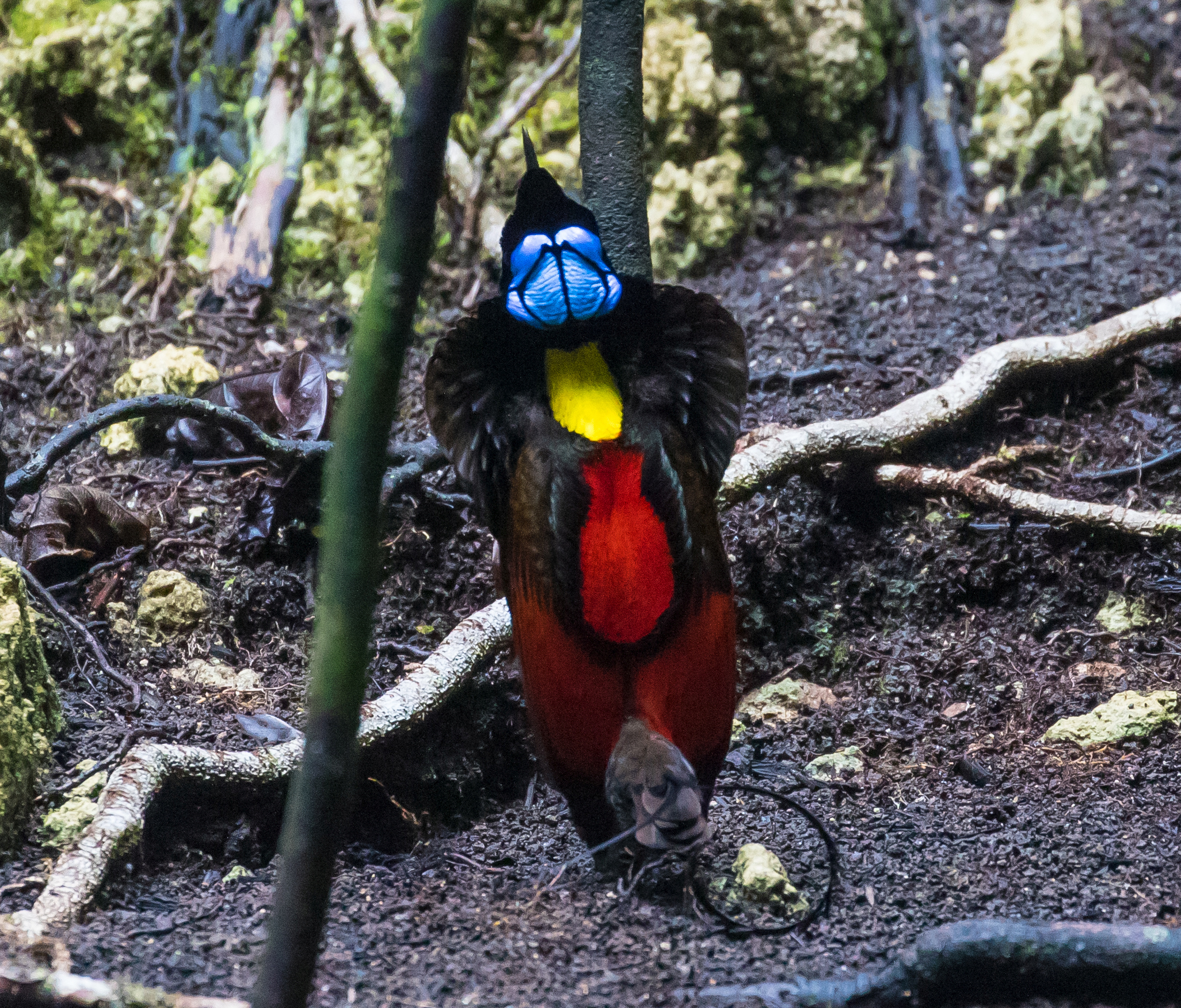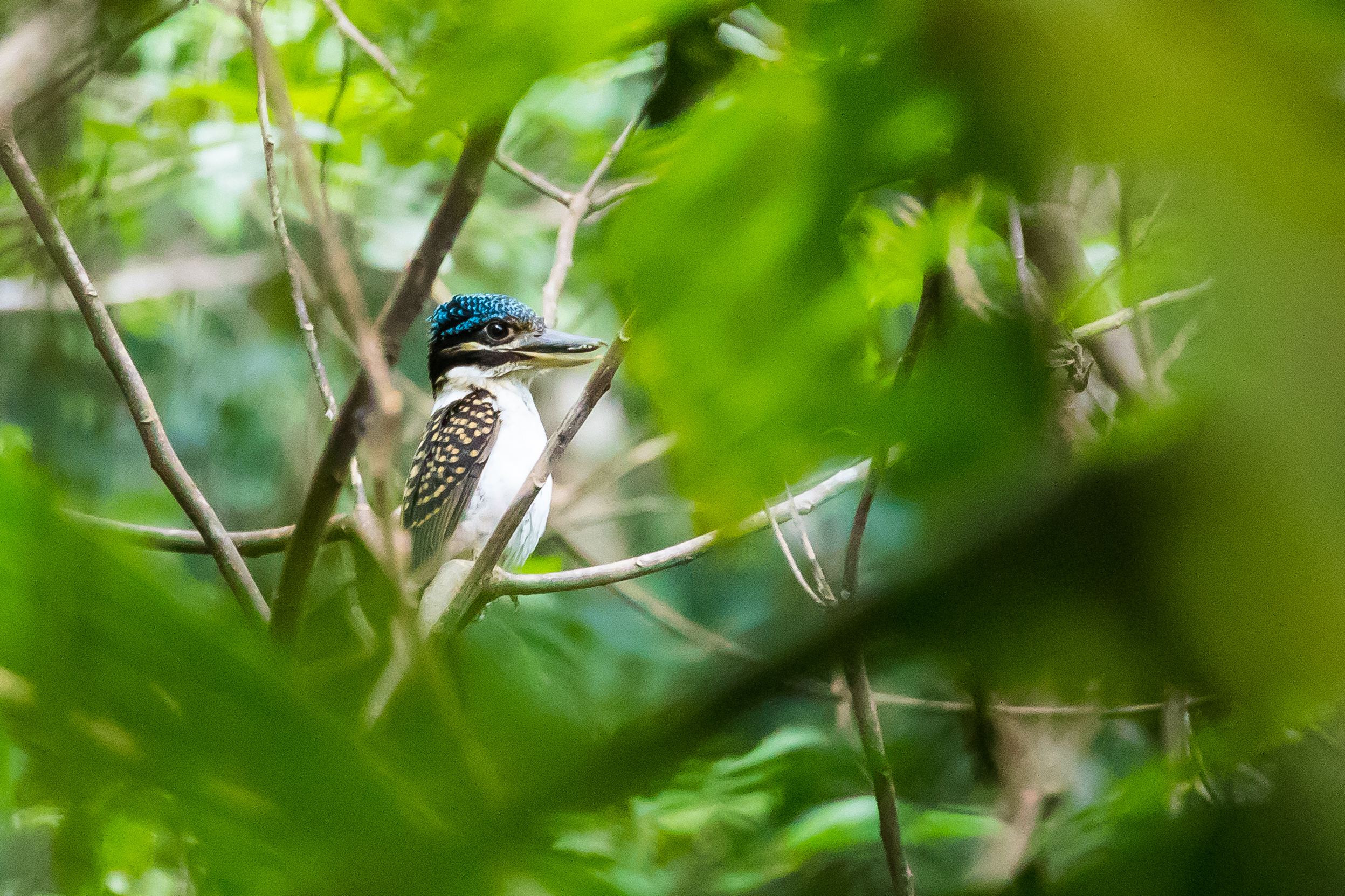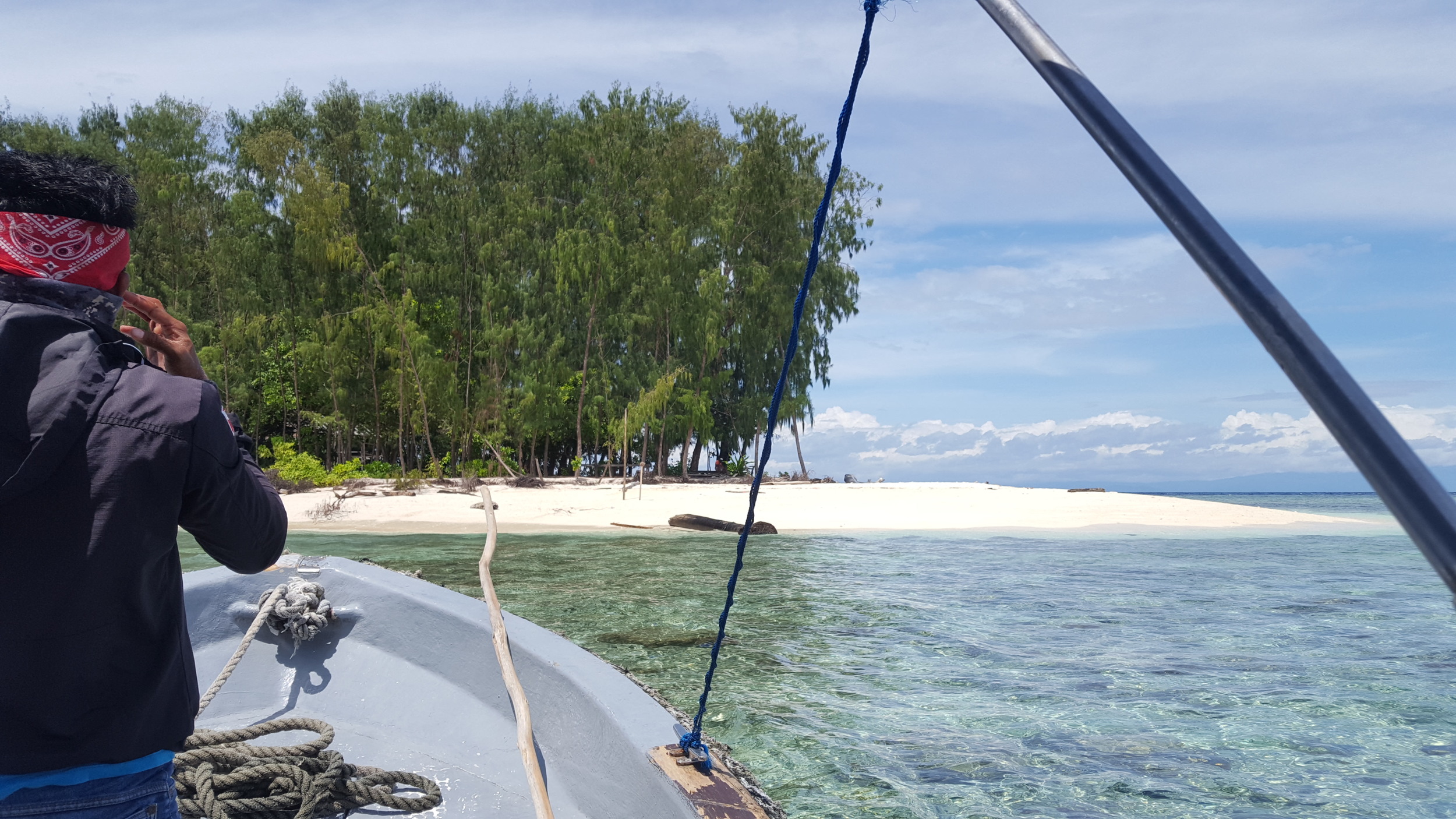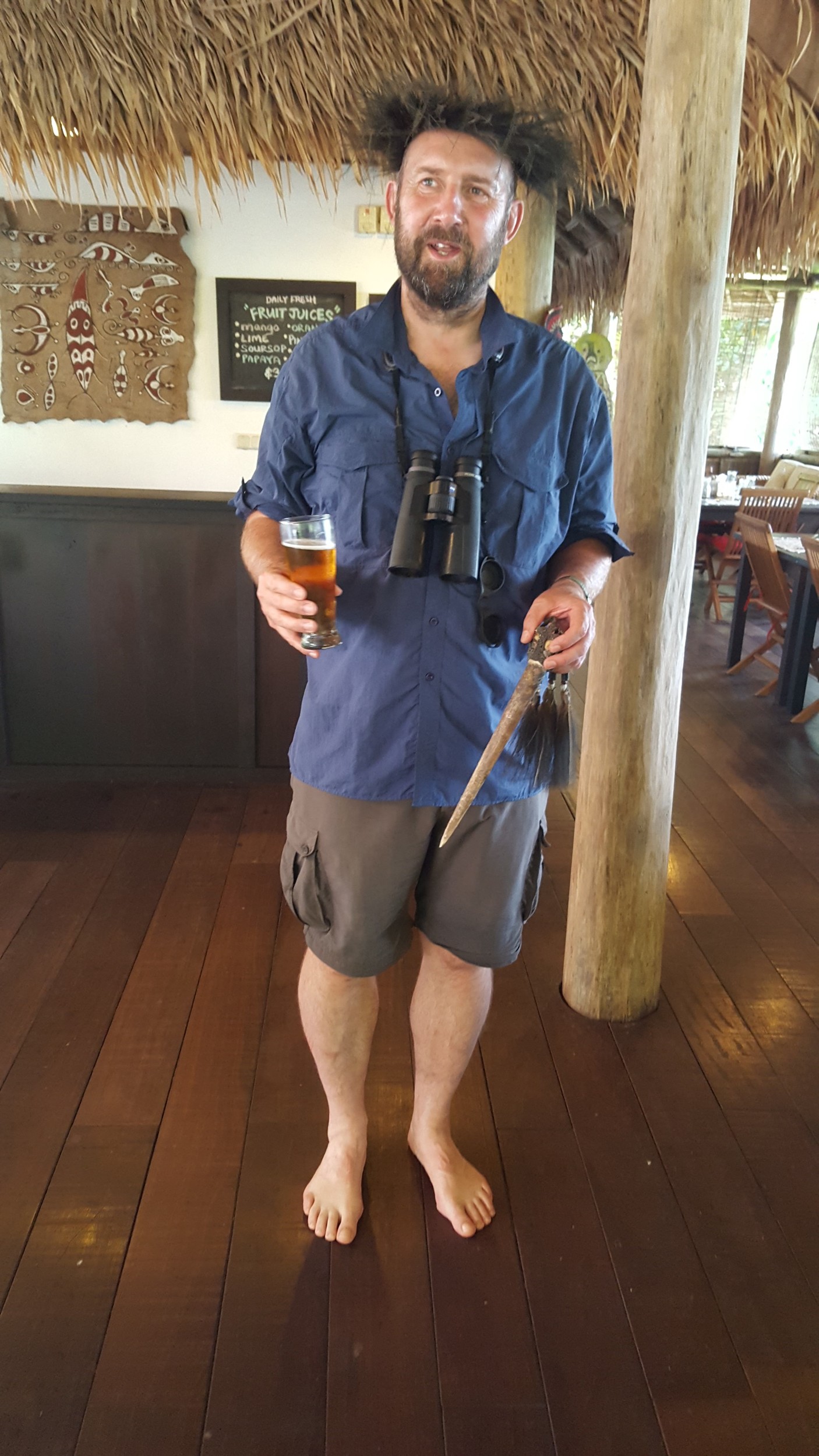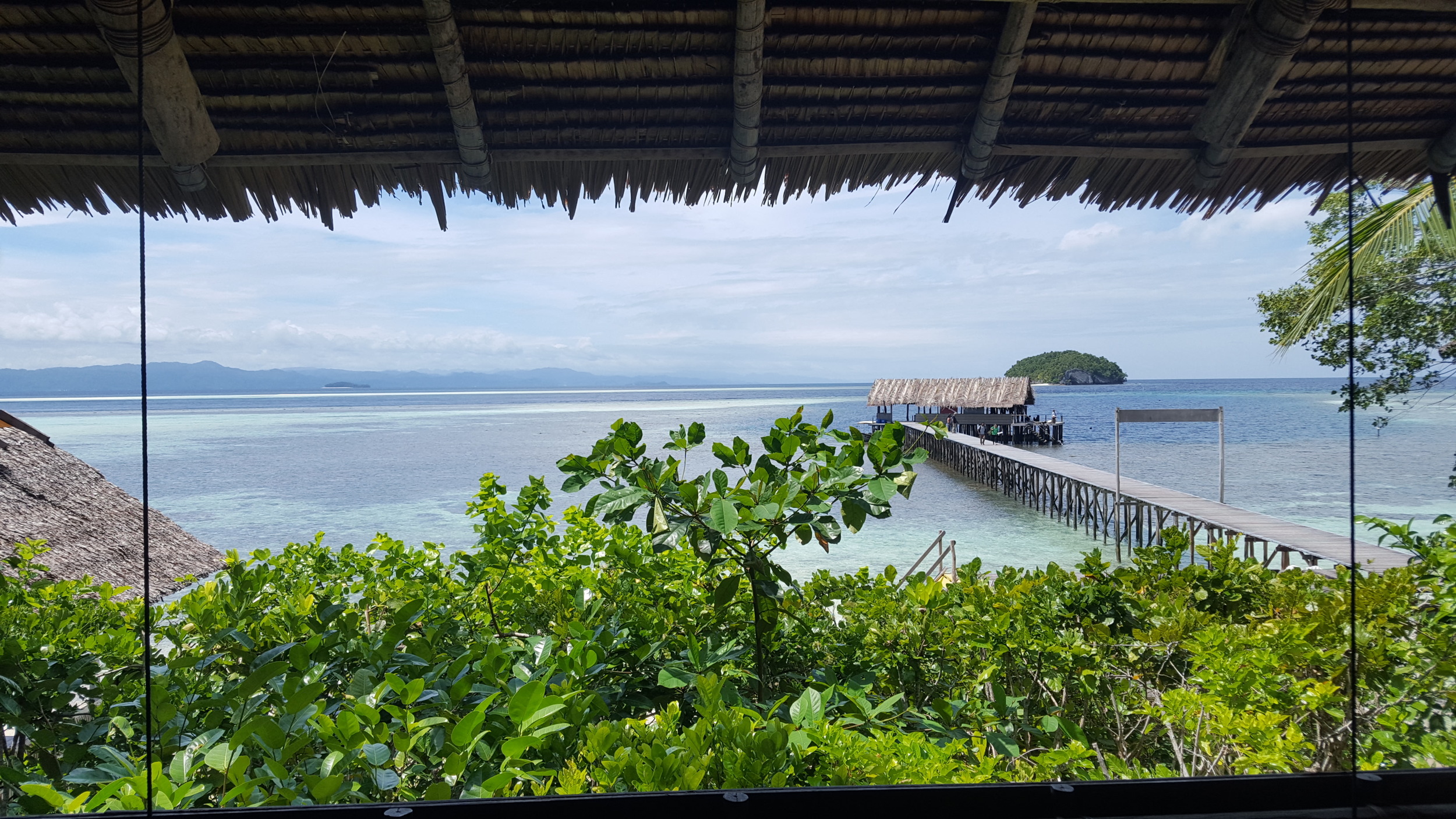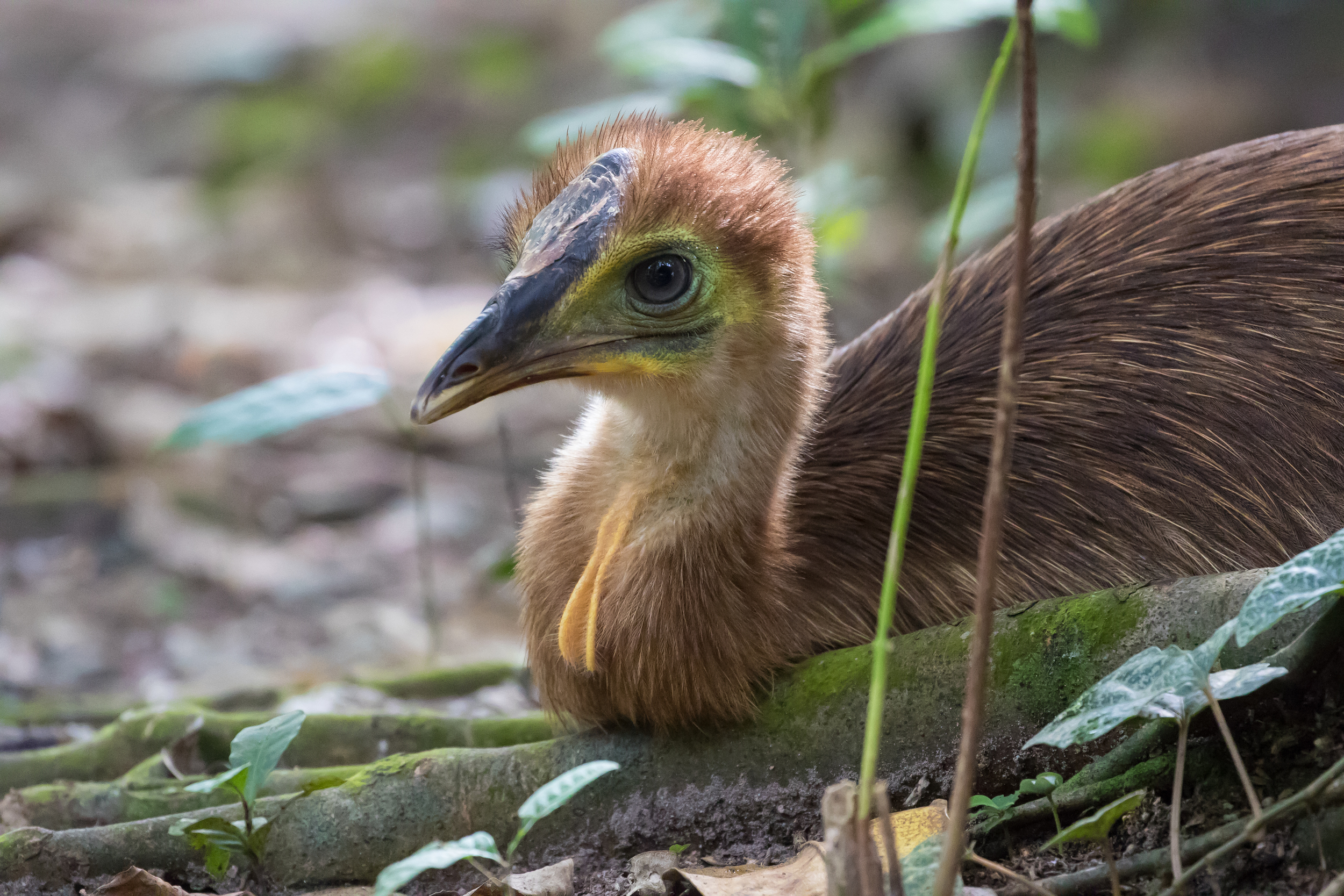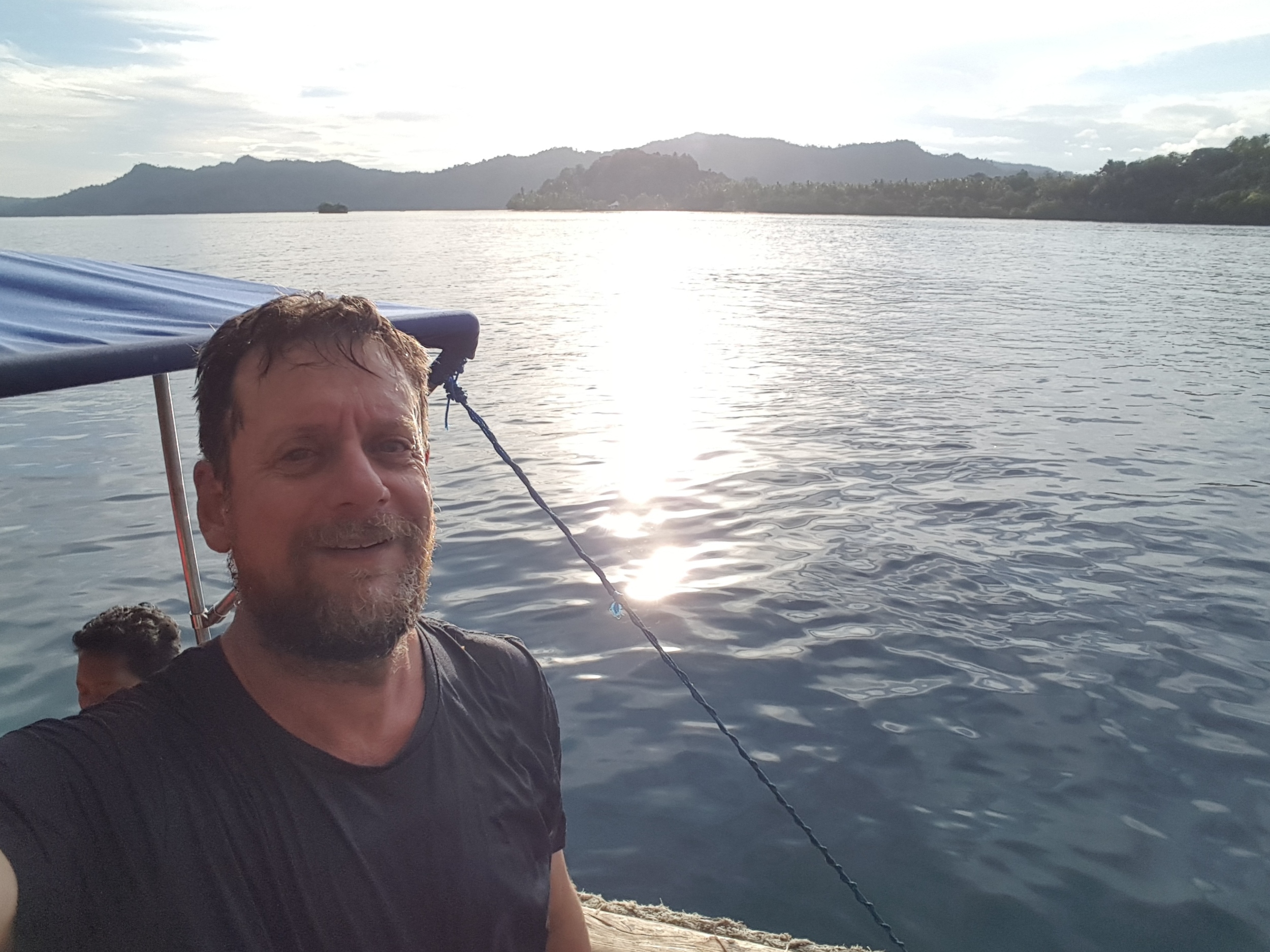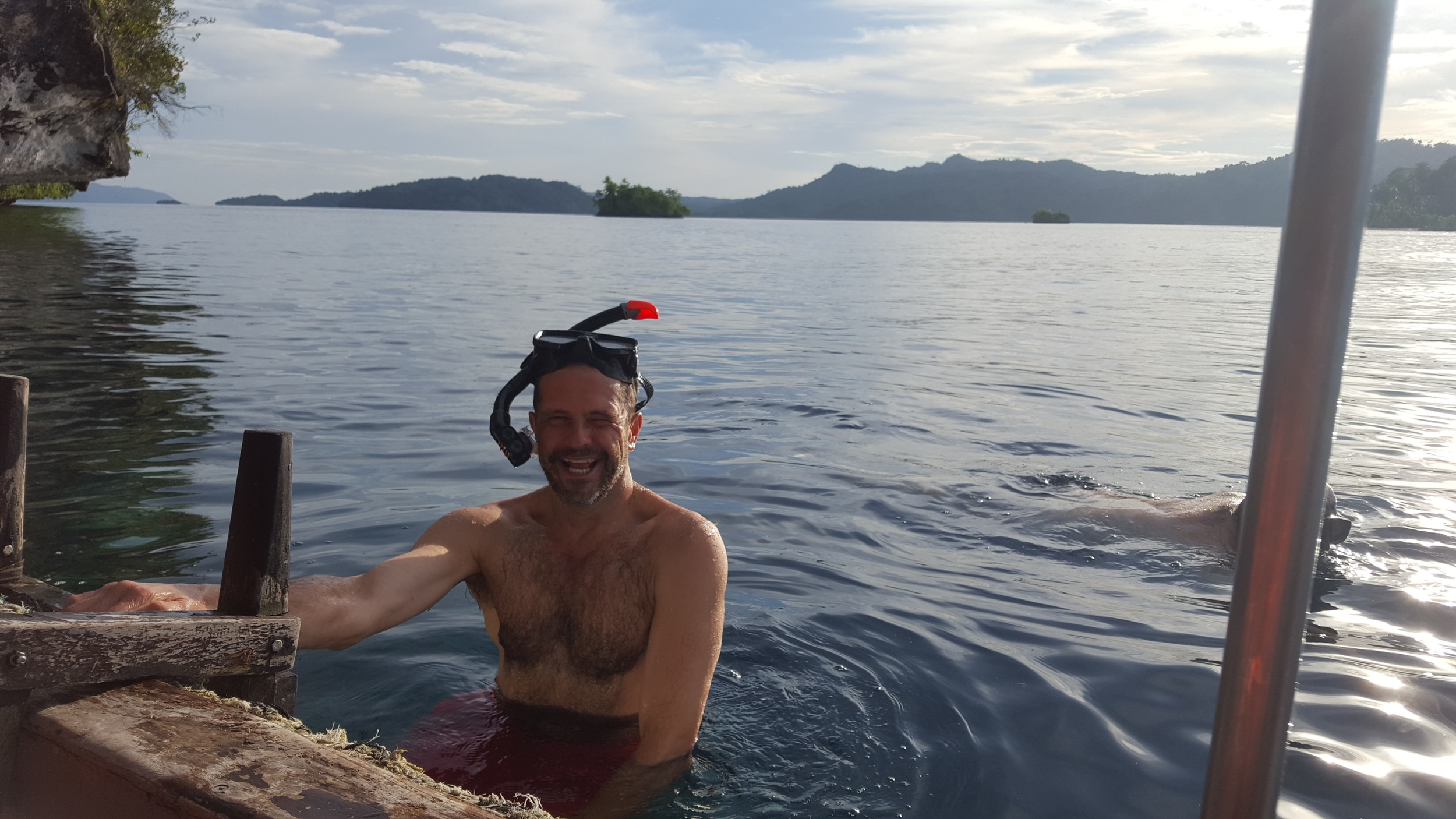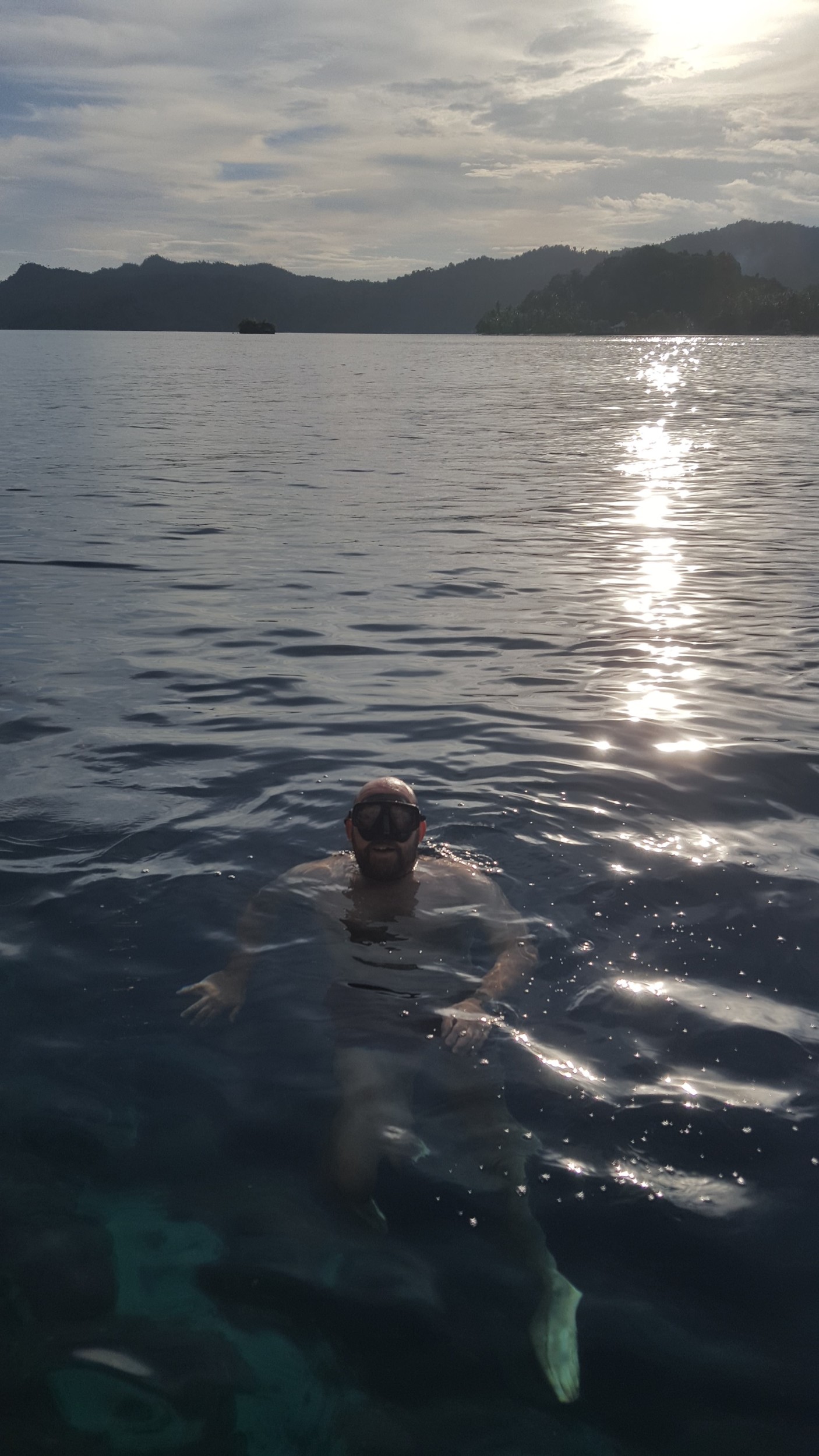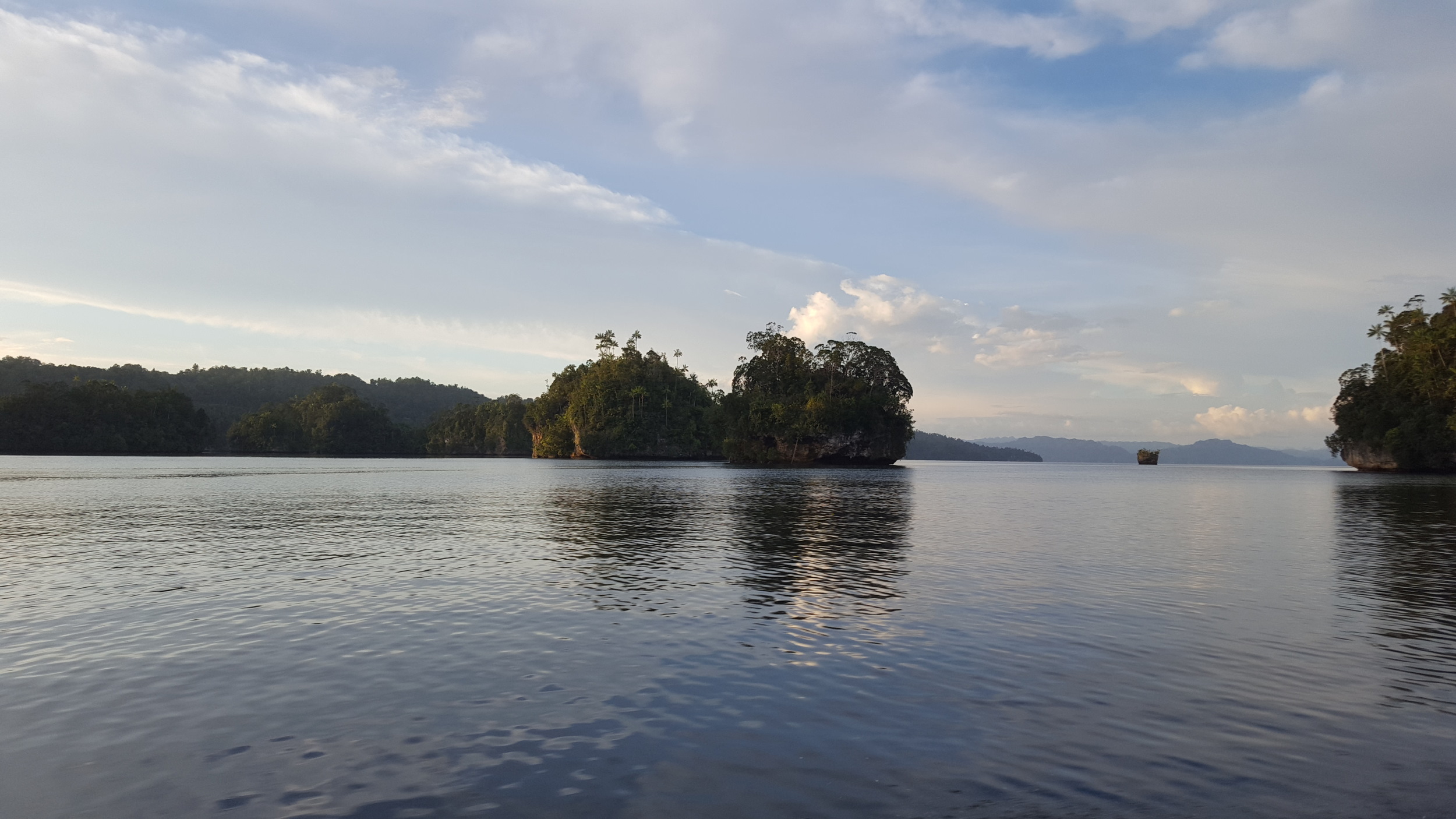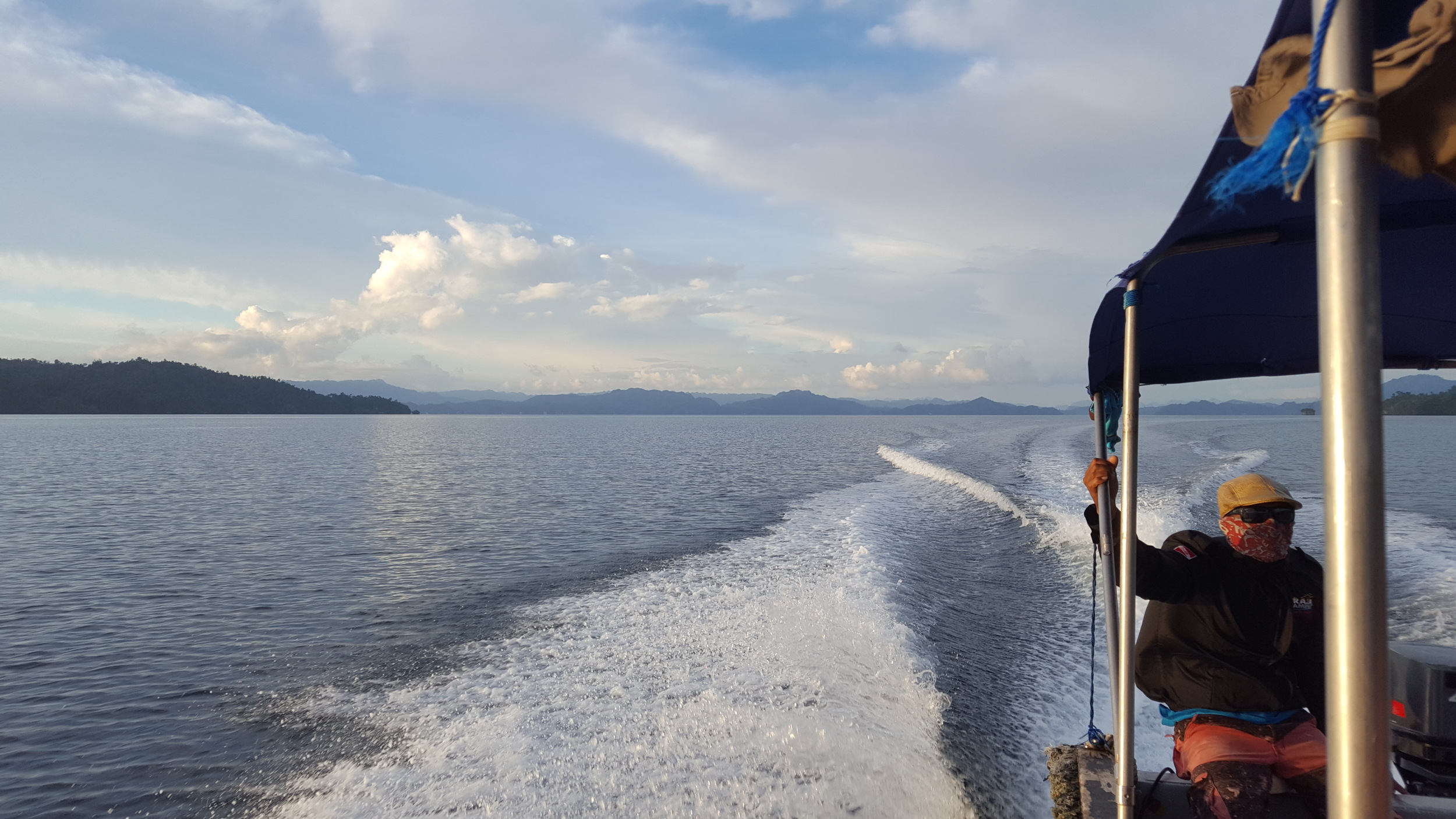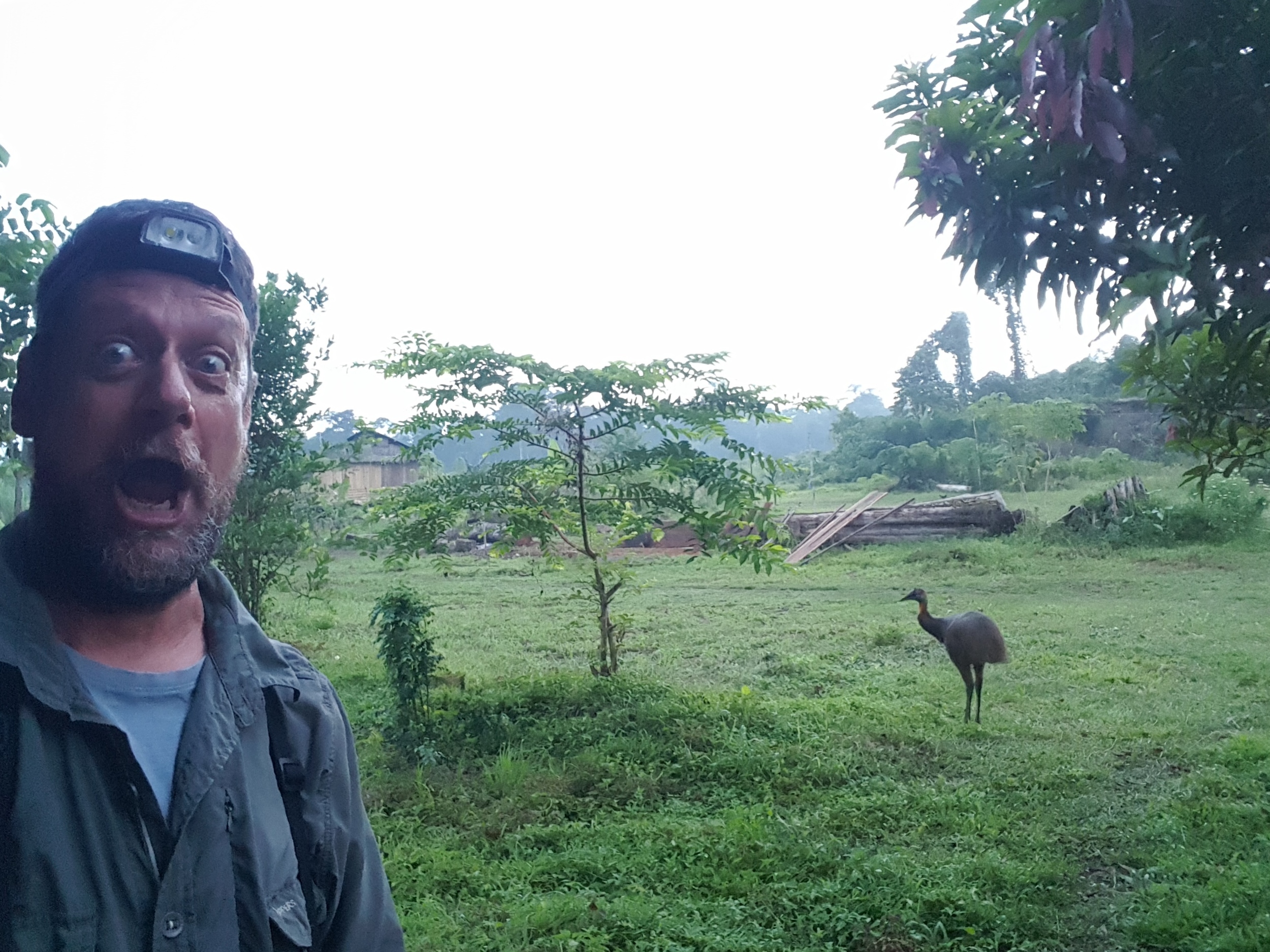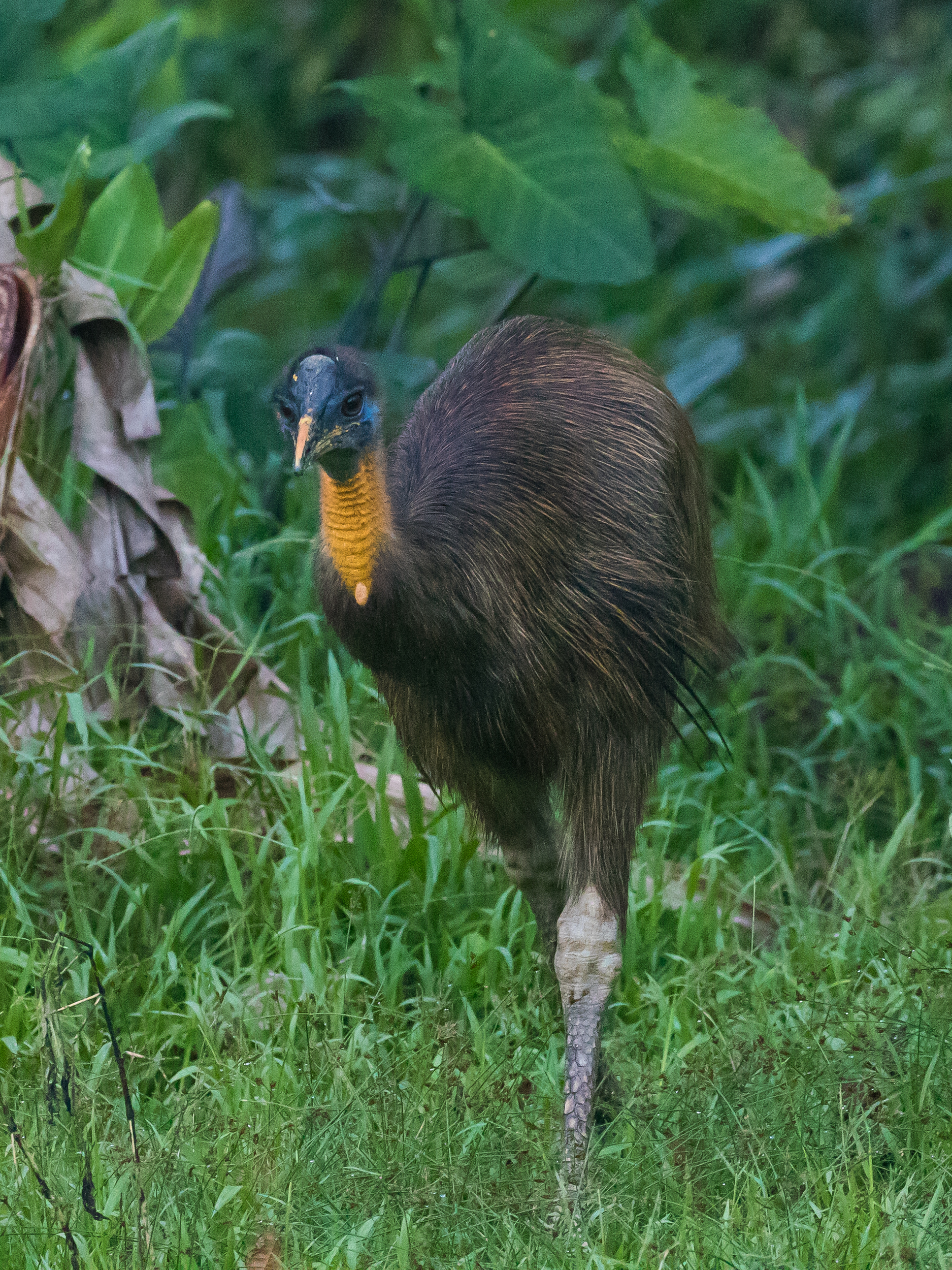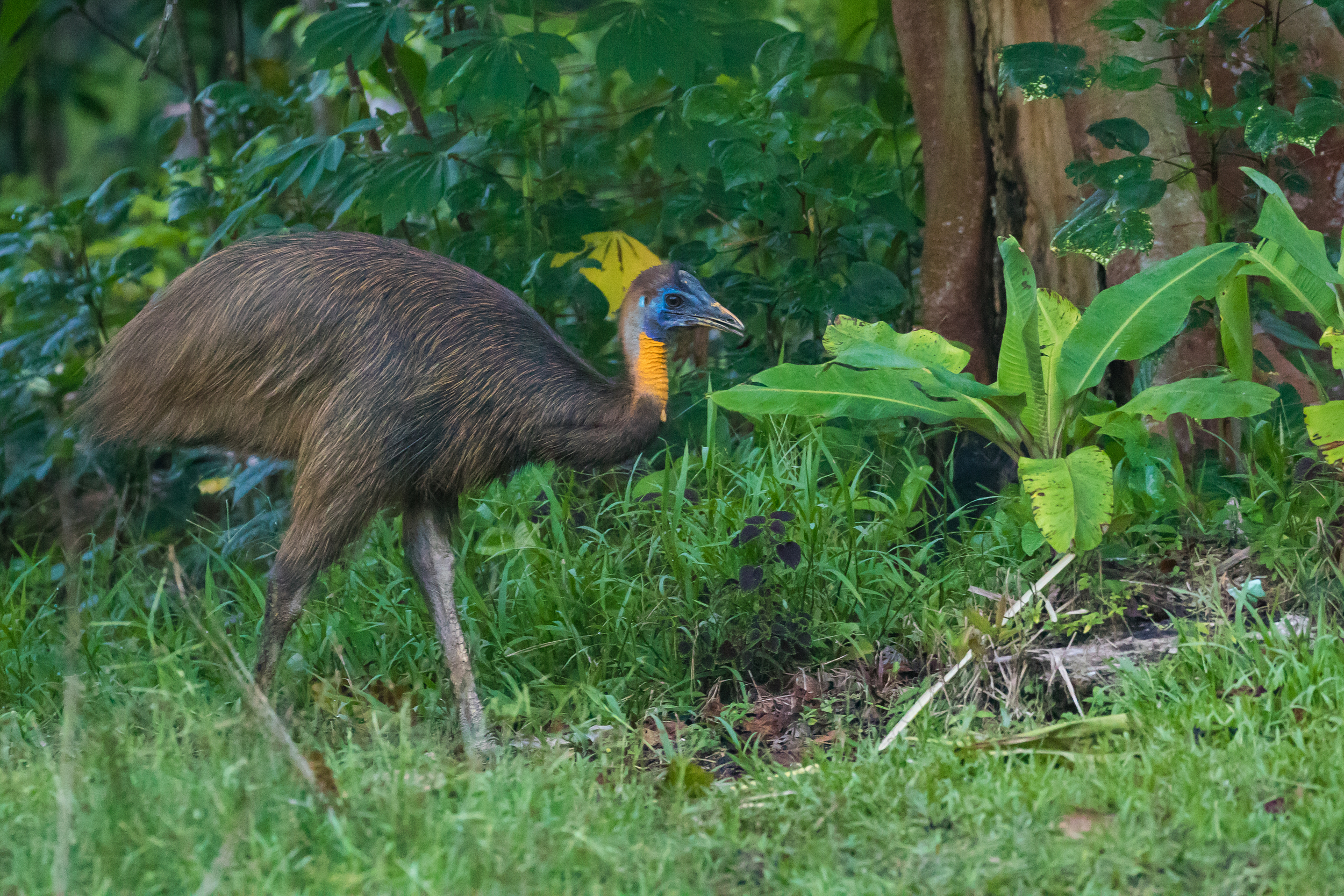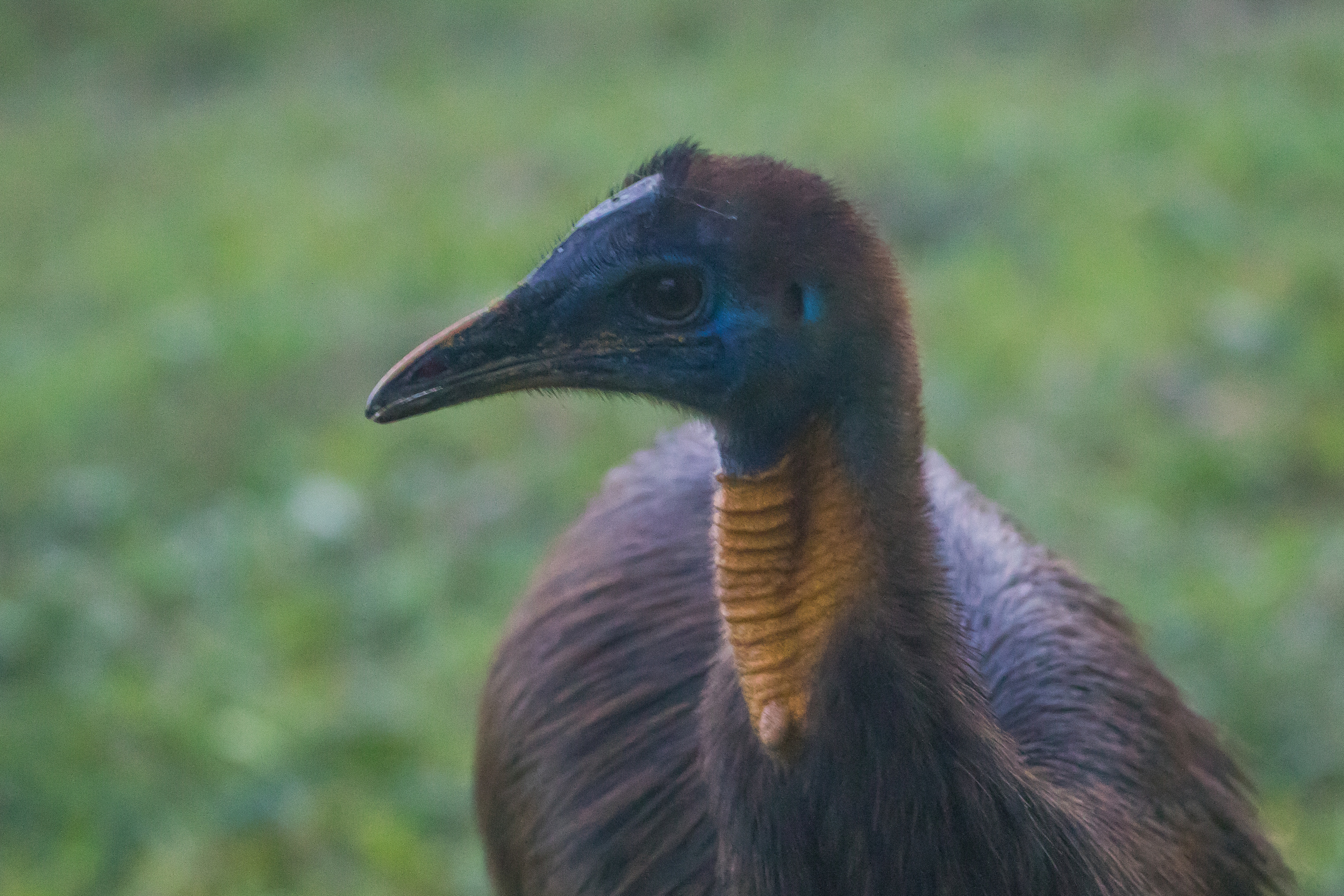Day 17, 28/7/18, “Welcome home, Benny”
We have – by the standards of the last few weeks anyway — a crazily late rise in Manokwari, handing our bags to Shita and Benny for airport check-in at 7am, then a leisurely breakfast. One of the marvellous little luxuries that Shita has spoiled us with is that she has handled check-in for every flight for us – we hand over bags and passports, and have a meal or even a beer while she takes care of the waiting around and queues and stress. We rock up just in time to be handed boarding passes, clear security and get on a plane. I could get far too used this.
Today, though, we fail to avoid all of the stress involved with flying. Our flight time comes and goes and there is no sign of a plane. A significant delay this morning could have major knock-on effects — we have a ferry to catch in Sorong and if we aren’t there in time we will lose pretty-much an entire day and one of only 3 nights in our next destination, the island of Waigeo in the Raja Ampat archipelago. Even as time ticks on Shita seems fairly relaxed, so I do not stress too much but my mental calculation suggest we are now cutting it fine if we don’t leave in the next half an hour. At seemingly the last possible moment for us, our plane arrives in Manokwari, we are called to board and then we are underway for Sorong.
We’ve actually made up a bit of lost time, so once we are in Sorong, Shita sends us to a local hotel where we drink beer and eat pizza (yep, first meal without rice, and first cheese in 3 weeks) while she takes care of the logistics of our ferry ride to Waigeo. When the moment is just right, we get a call to pile into a car, and are whisked to the port. We stroll down the bustling jetty and straight onto a comfortable fast ferry.
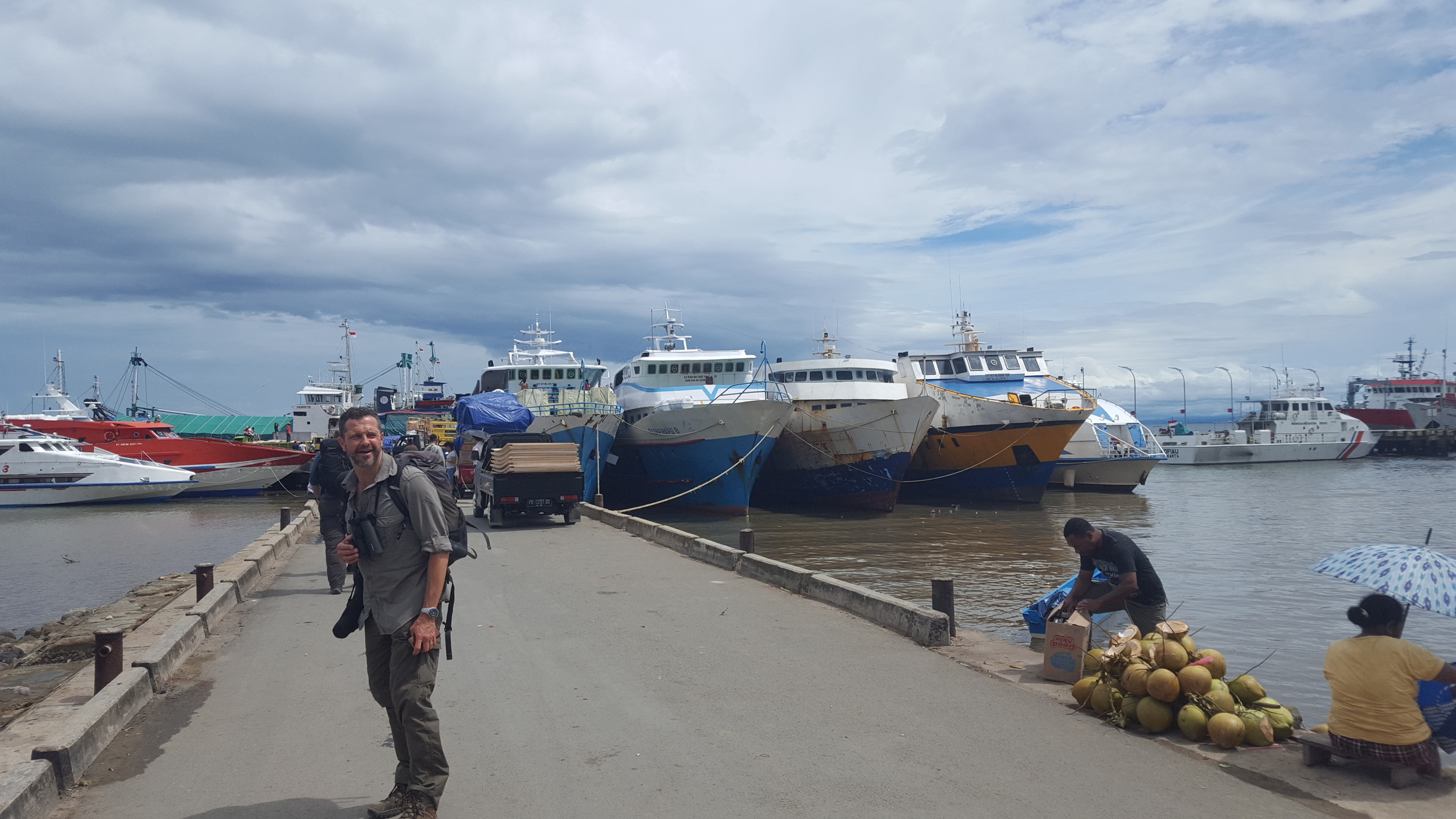
Once we have cleared the mainland and are in open water the captain is happy for us to go outside onto the bows. Steve and Jon stay to bird in case of petrels or shearwaters while I doze inside until woken by Steve calling – they have just seen a Bulwer’s Petrel. I head outside just as another petrel crosses the bows, though I cannot claim to have got enough on it. We do have Lesser Frigatebirds and Brown Booby before we get to the port in Waigeo.
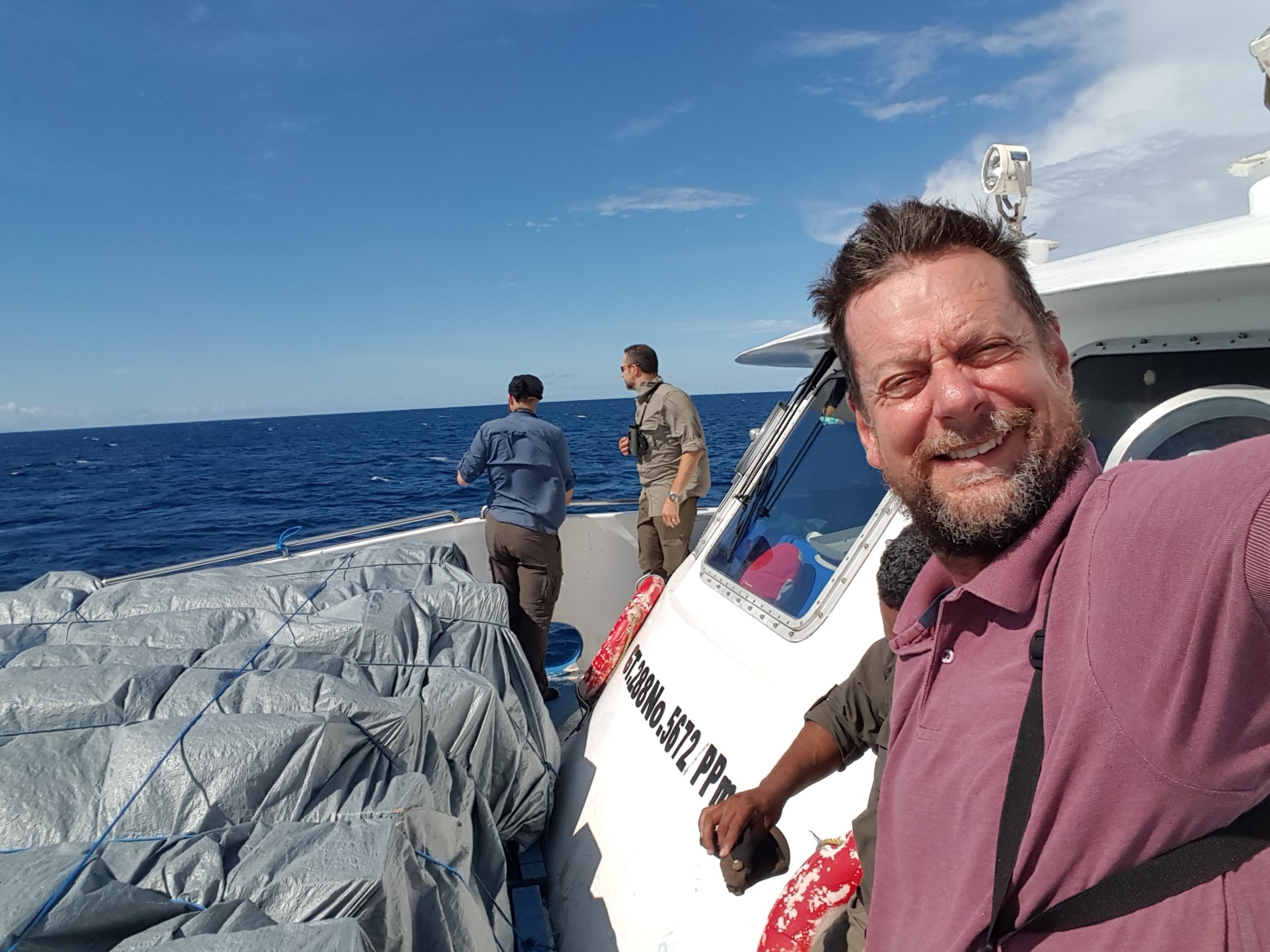
It is 16.30 and our bags are whisked by speedboat to the resort where will will spend the next 3 nights. We climb into cars and drive a windy road through the hills, picking up a good selection of lowland birds along the way.
Some are common birds we’ve seen in Nimbokrang, such as Red-cheeked Parrot, Pinon Imperial Pigeon, Dollarbird and Brahminy Kite. But at a couple of stops it is very birdy and we have some excellent encounters with Great-billed Parrot flying over, a massive Palm Cockatoo, and Whiskered Treeswift. We track down a couple of Claret-breasted Fruit-doves, a Papuan Cicadabird, and find a Lowland Peltops so Steve is able to grip that one back. Best of all we have a few flyover Red Bird of Paradise. Red BoP – a member of the “classic” Paradisaea, plumed bird of paradise family that includes Raggiana, Greater, and Lesser – is endemic to Raja Ampat so is one of our main targets. Initially we see a few females and then I see a male, whose long, bushy red plumes trap the late afternoon sunlight as it bounds across the clearing in front of us, ridiculous wiry tail streamers dangling and wobbling behind.
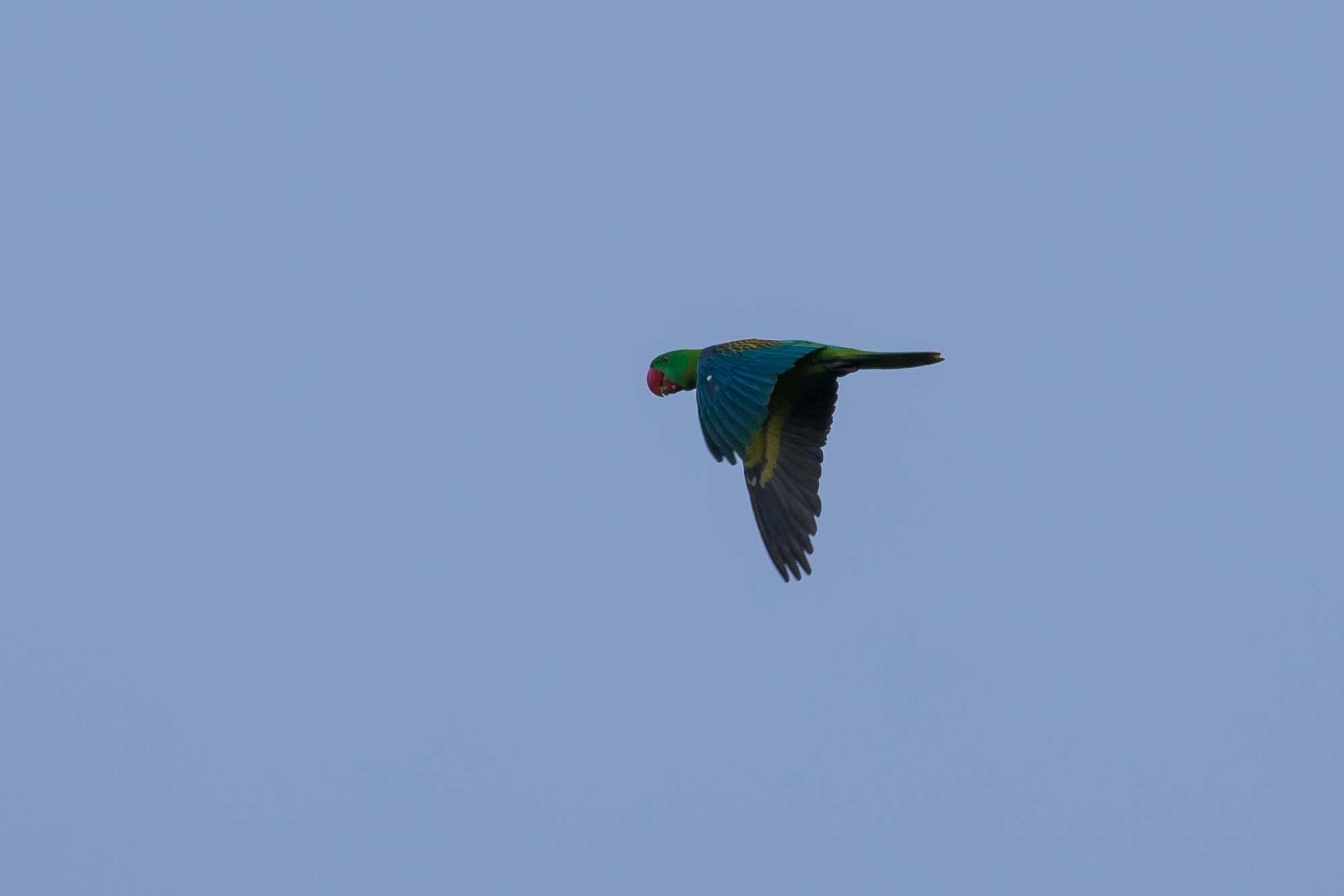
Most punters arrive at the Raja Ampat Dive Resort by boat, but we have come via the tradesman’s entrance and have to clamber down a steep trail and steps to arrive at a stunning beach-front resort surrounded by forest and palm trees. My room is basic, but just gorgeous, with a comfortable bed, decent shower, and a balcony that looks out over the bay, water so clear I can see the reef beneath.
As we unpack and settle in, clouds gather and by the time I am ready to walk the short distance to the open-air restaurant to join the others for a beer (yes, we are finally in a place where we can openly buy and consume the amber nectar) a massive thunderstorm has unleashed itself. It will rain heavily for the next couple of hours. No matter, as long as it’s dry tomorrow… There is some bad news though: the Ducking Futch are here too!
Day 18, 29/7/18, “How do you do, Mr Wilson?”
Wilson’s Bird of Paradise is considered by some to be the best bird in the world. It certainly has a good case: it is rare, found only in Raja Ampat; it is amazing looking, bedecked in stunning primary colours; and it has a fabulous display. Until recently it was also very difficult to see. The only known accessible sites were in the island of Batanta at 400m a.s.l. involving a long steep trek in the dark for anyone who wanted to witness Mr Wilson at his display site. Only in the last few years has there been ferry transport to Waigeo where there is less logging pressure and Wilson’s can even be found at sea level. It’s still not easy to get to – by today, Day 18, I’ve undertaken 7 flights and a 2 hour ferry ride – but at least we know there will be no more muddy trails.
Before heading to look for Wilson’s, we have two other targets. We drive a short distance from our resort before dawn and manage to find a Papuan Boobook. I grab a record shot of the cute chocolatey Ninox this time, but we cannot encourage it to come close to us.
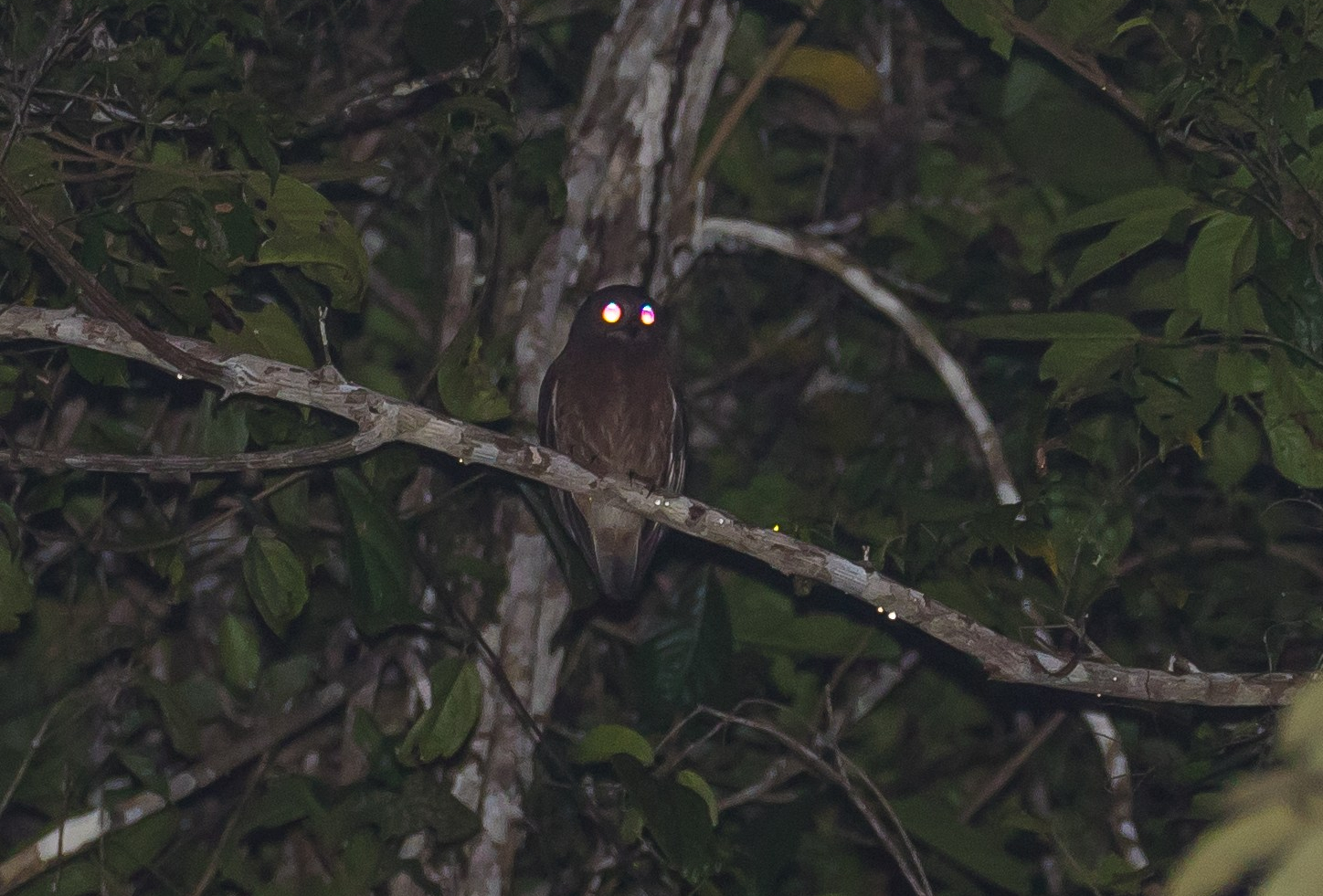
Next stop is a display tree of Red Bird of Paradise. The view requires us to crane our necks (we are used to this by now, and I am sure the muscles in my neck bulge like a weight-lifter’s biceps), and they keep us waiting for a while. First on the scene is a Glossy-mantled Manucode, but at 6am a male Red BoP arrives. It spends quite a while sitting and preening itself semi-obscured, but once a couple of other birds arrive in the neighbouring trees it moves to its favourite display post and poses nicely, as well as dancing on the pole and shimmering its wings. The others fail to join it for a full lek, but we are happy to leave in the knowledge we still have the day’s main course to come.








We drive a short distance through secondary forest until we pull up a few minutes before 7.30. Much of this area is Benny’s land – his home is the next village after the resort – but to spread the love and make sure everyone benefits from eco-tourism Benny and Shita have brought us not to his own, but his neighbour’s hide. We walk a short distance through the forest to a nicely built hide and within seconds a stunning male Wilson’s Bird of Paradise drops from bushes at the back of his display court: “Mr Wilson will see you now…” This is all so fast! In a panic I fail to adjust my camera settings and grab only 4 horribly blurred pictures before he disappears.
Fortunately he is not long gone and when he returns we are treated to yet another trip highlight. For more than half an hour he zips around his court displaying to at least 2 females in attendance. His primary colours are so bold and pure that it’s almost like a child has been asked to colour him in. The dominant colour is red, all over his body and back apart from a bright yellow circle on his neck that he shows off by crouching on the ground, kinking his neck and pushing his head down to the ground. His head is bright blue, bare, wrinkled skin like a blue brain, seemingly held in place by a black “cage”. The dark-green of his underparts is so dark it appears black, having sucked all the light into it. His tail is a similar shape to Magnificent BoP, but thicker, like a thin tape rather than a wire. Several times he poses vertically low on a favourite post, and fans his neck out to show the female on the stick above.







Louisa’s reaction when she sees my photo of the displaying bird: “it looks like an Aboriginal flag”. She has a point:
During the display a Dusky Scrubfowl calls and I see it moving to the right if the display court in dense scrub. The view is poor, and much as I would like to see this, the spectacle of the world’s best bird performing a few metres in front of us somehow draws the attention away. In any case we later see a Scrubfowl from the road. After an nearly an hour with Mr Wilson, the females have departed and he has retreated to the side of his display court to keep an eye on things. We turn to Benny and our local host to ask about our next target, Western Crowned Pigeon, or Mambruk. Our local guy is telling us that he has regularly been seeing them at a fruiting tree about 100m from here, when within seconds, we hear one that sounds like its coming from exactly the spot just described.
We follow Benny through the forest and sure enough his hunter’s eyes pick out a superb Western Crowned Pigeon on the ground. We all have good views but it slides away through the forest before we are sated or have even record shots. We give chase hoping that it will flush up to a tree for better views, but it stays on the ground and manages to elude us. Never mind.
Back on the road we bird on foot continuing to pick up goodies. Common Paradise Kingfisher calls but as we found in Nimbokrang, is a bugger to see. Yellow-breasted Boatbill is a lifer for me, even though it is found in Australia. Papuan Pitta is also found in far north Queensland but this is not a lifer for me – I had an epic encounter with one in the Adelbert Mountains in 2008. But any day you see a pitta is probably a good day, so I call back to it by whistling through saliva collected in the back of my throat to get a suitable warble. Amazingly this is answered and not long after guess who — Benny — finds it out for us. A fantastic bird to have on the trip list, though it can’t often be the case that a pitta fails to break into the list of top birds you’ve seen in the last 3 hours.
We have more endemics to look for and pretty soon we get good views of Raja Ampat Pitohui. They respond well to Benny’s whistles but are flying around excitedly and rarely stop so it takes me a while to get views I am happy with. Then another goody – our first perched Papuan Dwarf Kingfisher!
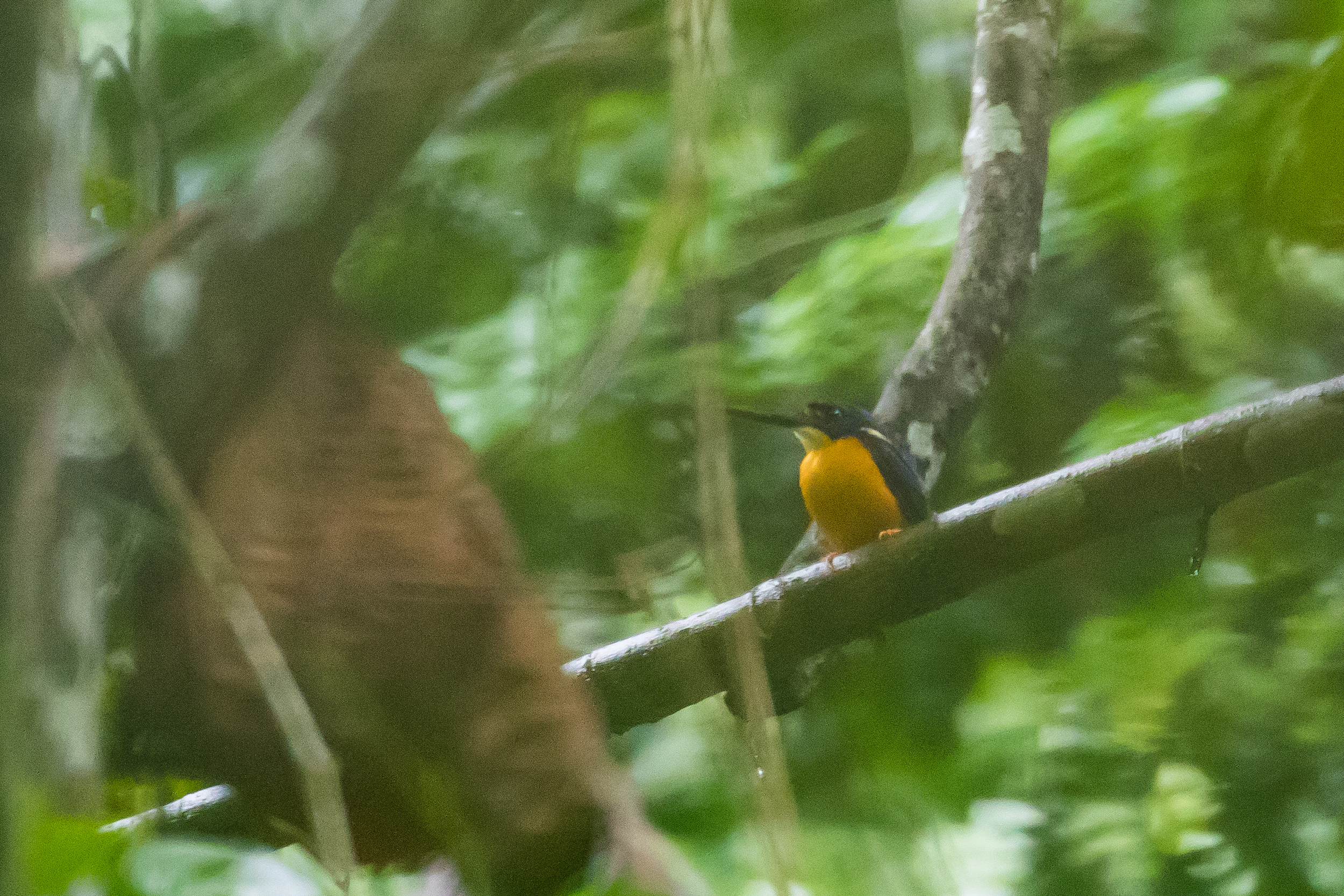
We are back in the lowlands and consequently by 10am it is oppressively hot and humid and bird activity is much reduced. We start walking back to the cars when Benny calls: Mambruk! There is one on the road ahead of us. We follow at pace as it walks away from us, even breaking into a jog – this seems to be the accepted technique and apparently often results in a bird that will stop and watch you, or fly to a perch from which it can be viewed. But sadly for us this bird slides off the track into the forest and we cannot relocate it.
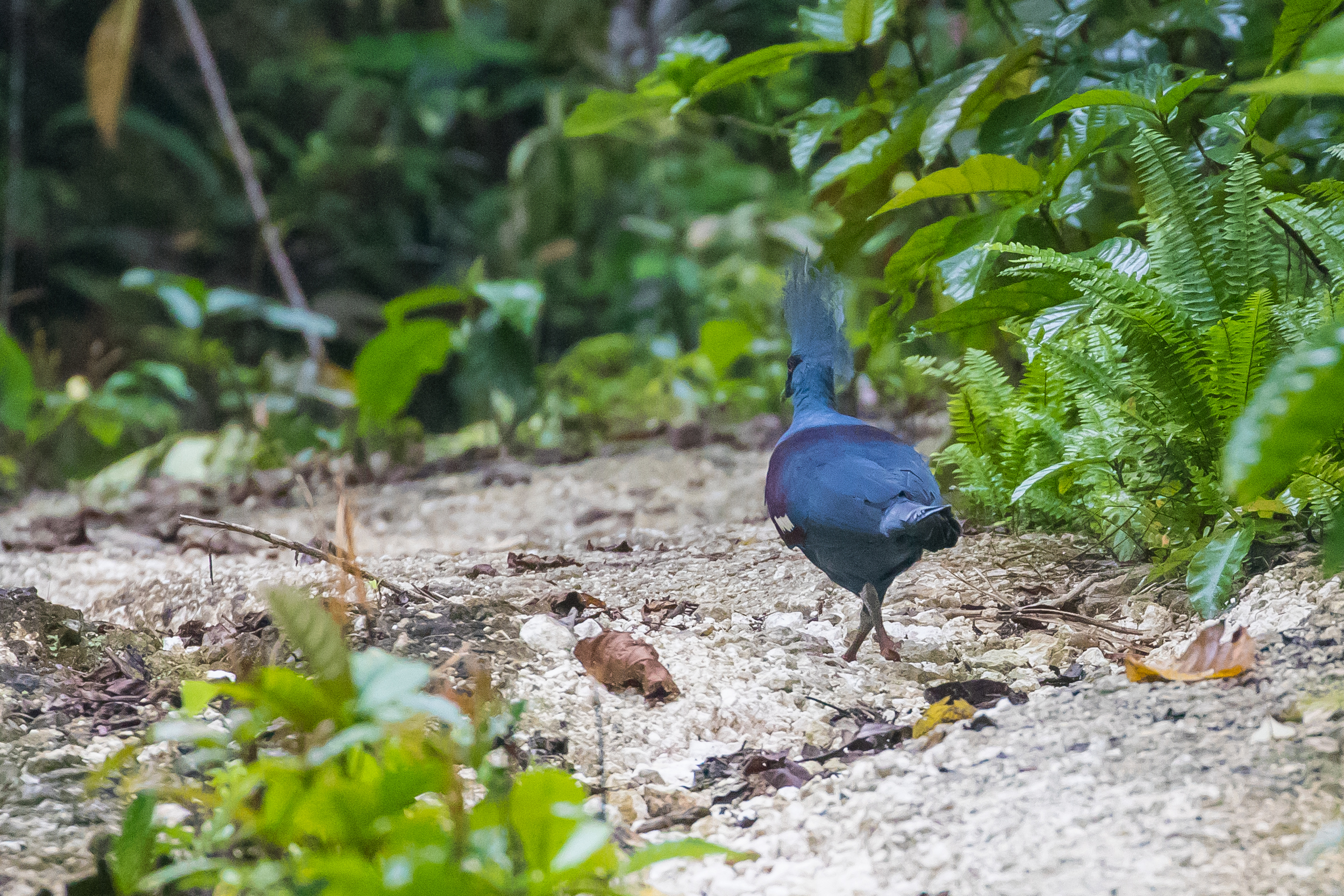
It has been a stellar morning. Back at the resort we swim in balmy, clear water and allow ourselves a few beers and a post-prandial Nanna-nap as a treat. Trudging up and down the Ibele Trail in the dark and cold and rain Steve Young said “Let no man call this a bloody holiday”. That seems a lifetime ago now that we have all our targets under the belt. We risk the wrath of families by taking a self-indulgent celebratory selfie and posting one of the few facebook updates of the trip.
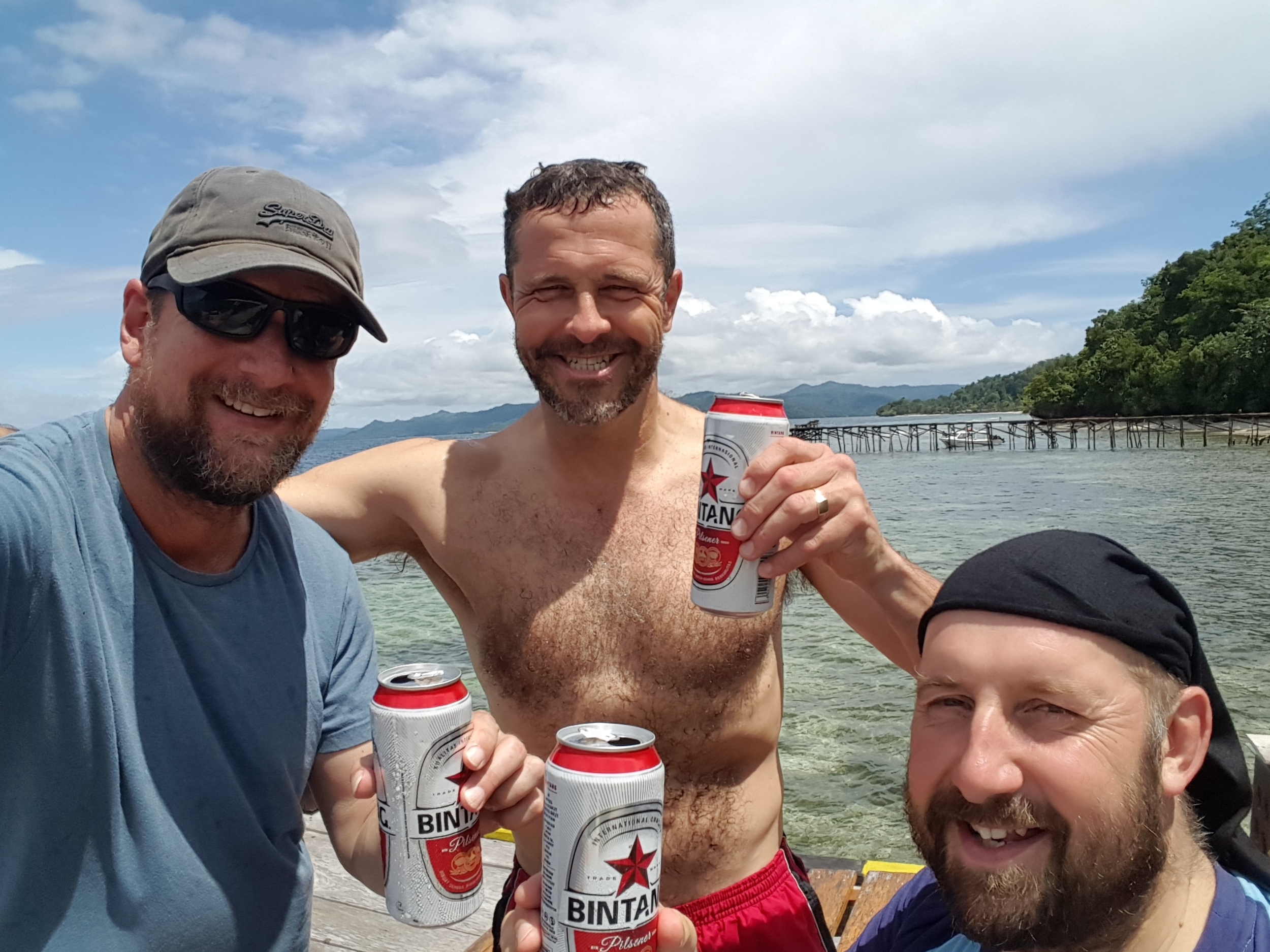
But this is a birding trip and if you snooze, you lose. At 3pm, I emerge from my nap onto the balcony to see the resort owner looking up into a tree outside my hut. I grab optics and join him — a pair of Papuan Frogmouths is roosting a few metres away from my hotel room. What a nice relaxing way to grab a lifer! I’d been hoping for this but expecting to have to head into the forest after dark.
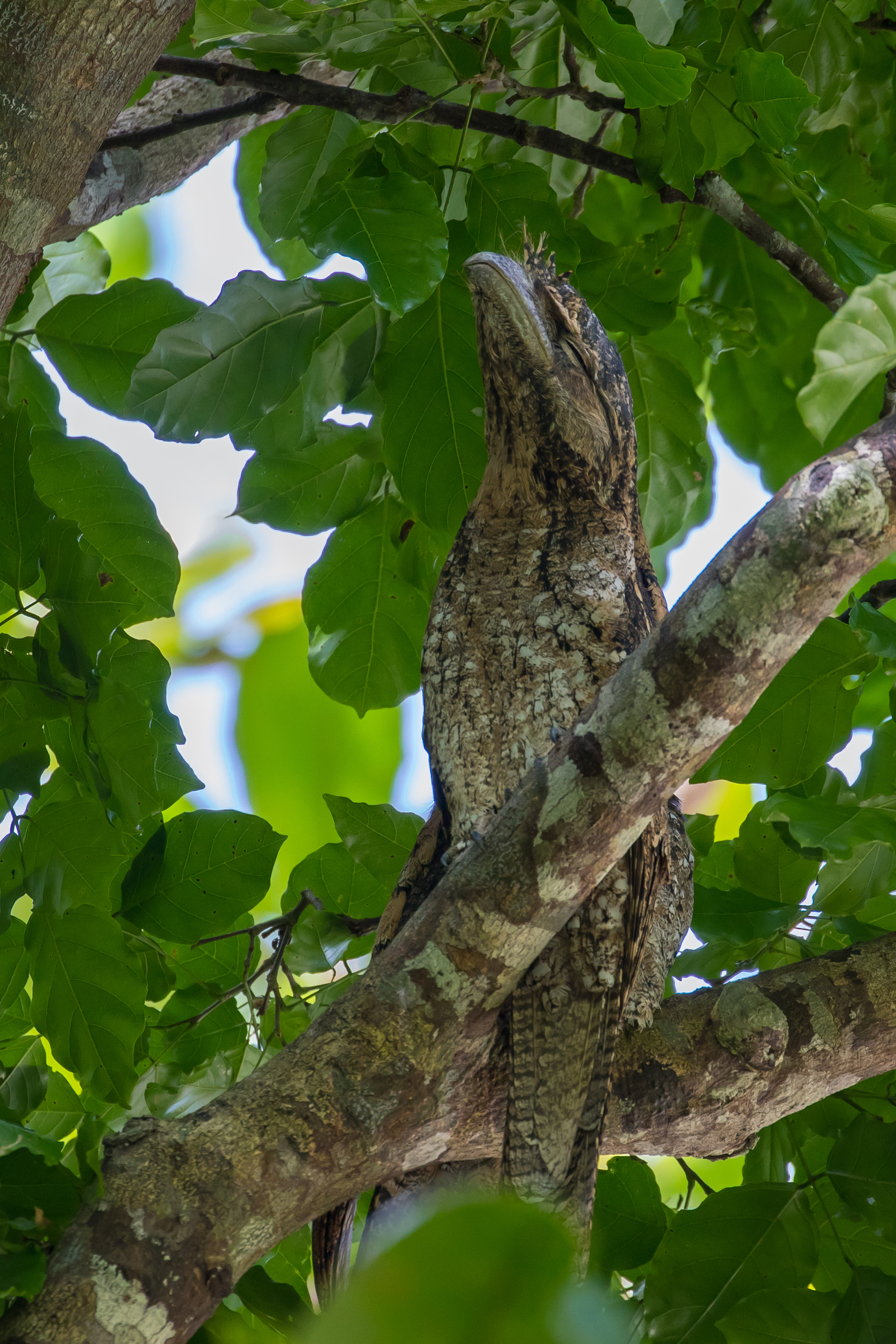
Jon needs Beach Kingfisher, and I have heard one shuttling back and forth as I’ve been dozing. We walk along the beach in search of it, first finding a Sacred Kingfisher, then two Beach Kingfishers.




At 4pm we drive a short way to some gardens and scrubbing forest at the back of one of the dive resorts. We are hoping for Golden Monarch. Though we dip on that we do have an female Frilled Monarch and lifer Spot-winged Monarch (another species also found in Qld). A few Rufous-bellied Kookaburra are conspicuous, then back on the road we see Eclectus Parrot, Shining Flycatcher and Ruby-throated Myzomela.
We have one more target in mind, and travel a bit deeper into the forest on the route we took to see Mr Wilson’s this morning. We stop at a spot known to Benny and play a call we are familiar with and have heard regularly in the lowlands: Hook-billed Kingfisher, a crepuscular stonker that can be a bugger to see. Steve and I ticked it off in ’08 when his eagle-eyes picked out a distant silhouette at dusk in the Adelberts. Shita assures us that from time to time you can come across a responsive bird in the daytime. And today our luck is clearly in. A bird responds and then – yet again – Benny is onto it through the smallest obscured window.
What a day: Wilson’s Bird of Paradise, Red Bird of Paradise, Western Crowned Pigeon, Papuan Pitta, Raja Ampat Pitohui, Papuan Dwarf Kingfisher, Beach Kingfisher, Hook-billed Kingfisher, Papuan Boobook and Papuan Frogmouth. Back at the resort we again reward ourselves with beer and tuck into the fantastic freshly caught and grilled reef fish on the buffet before the Ducking Futch can beat us to it.
Day 19, 30/7/18, “Winding down”
We begin the morning by returning to the narrow dirt roads above the resort where yesterday we had such a good time with Red BoP, Wilson’s etc. We’re hoping to find some of the less iconic species that we neglected yesterday, and I’m also keen to get better photos of Mambruk. In my trip notes on the day I described it as “birding Benny’s forest for various padders”.
As we pull up a few birds are hawking high above our heads – I’m surprised to discover they are Dollarbirds. Two new birds for the trip are Black Berrypecker (female) and Rusty Pitohui. We hear Papuan Pitta, Hooded Butcherbird and Rusty Mouse-warbler but do not try for them. But we do find another Western Crowned Pigeon. I still don’t get the frame-filling pictures that I want, or that we managed of Victoria’s, because the view down the road is a fair way off, but at least this bird is not pictured running away!
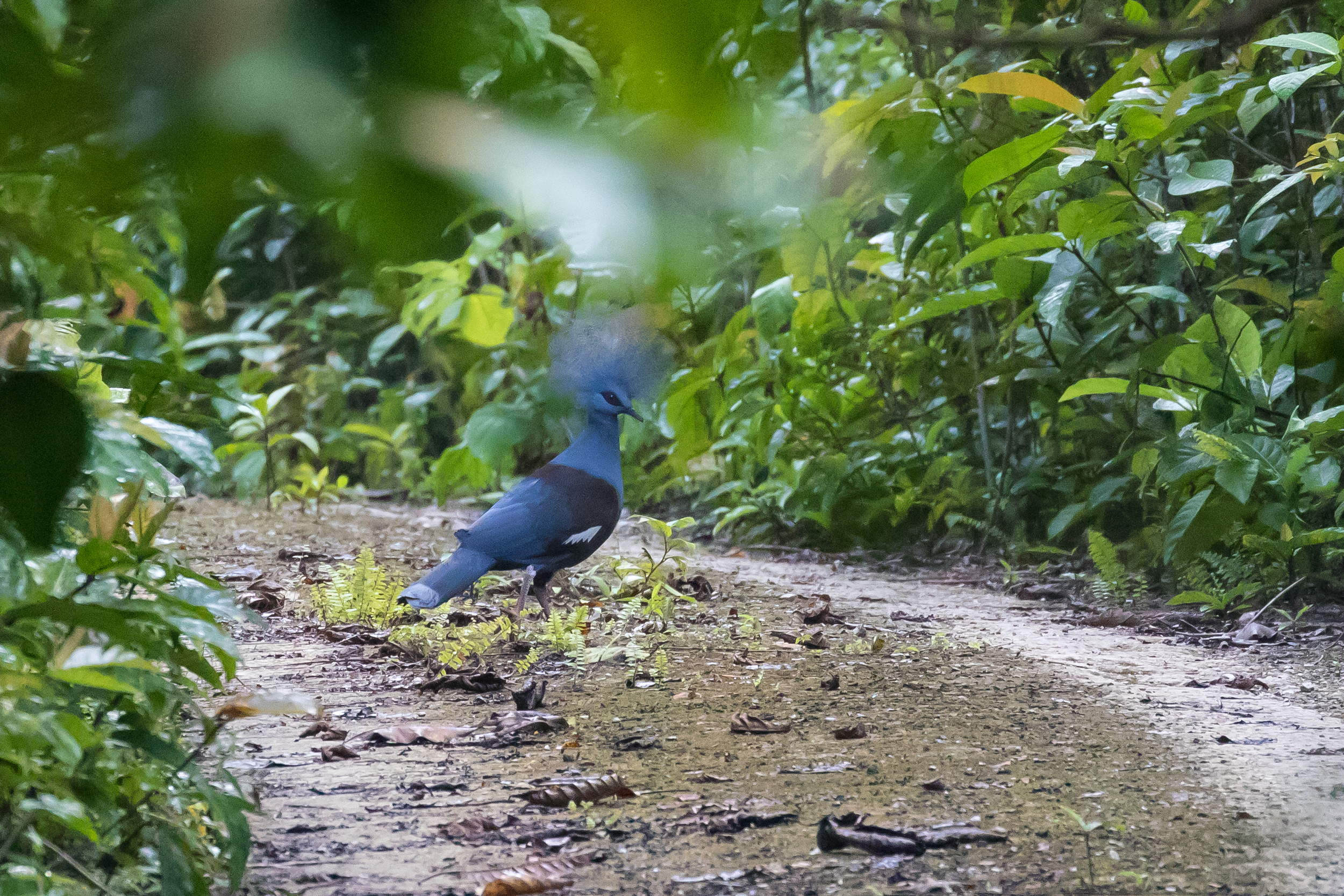
The only new additions to the trip list over the next two hours are Olive Honeyeater and Barred Cuckooshrike. The former we have probably in fact already seen, but we only realise this following some expert detective work from Jon the previous night. We also have yet another encounter with a Western Crowned Pigeon, our 4th in two mornings — they are positively common, here. We follow it walking for a couple of hundred metres or more along a broad forest walking trail. When we reach the end of the trail it does flush, and we follow it to a big tree. Just as it looks like it will land there for superb views I see it bank away at the last minute and fly much further, out of sight.
As we drive back to the resort a few Pied Imperial Pigeon fly past. This a widespread attractive pigeon that I have never run into before, so it’s nice to round out our “mainland” Waigeo birding with a lifer.
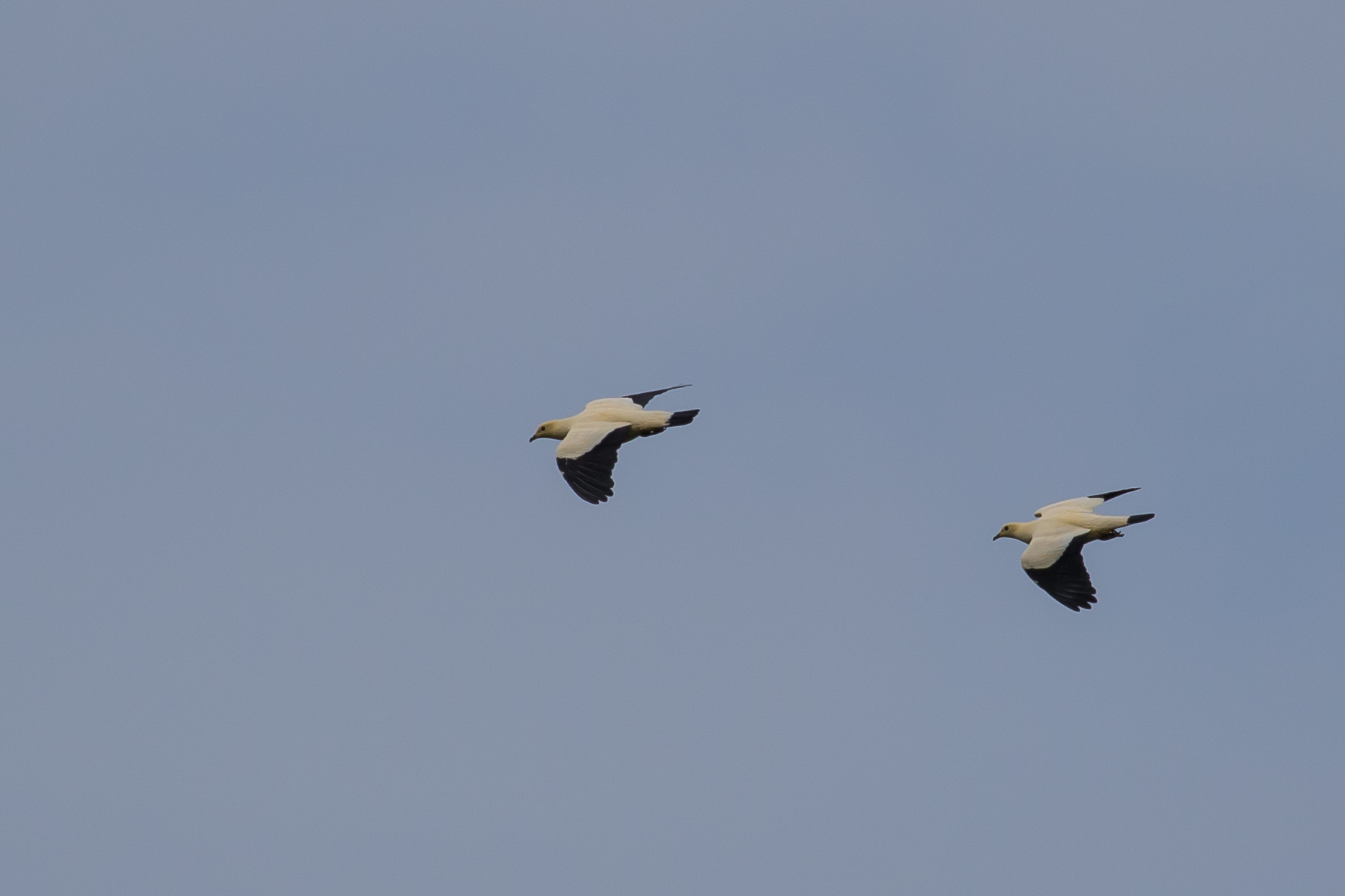
The plan for the rest of the day is to head over to another resort on the neighbouring island of Mansuar, exploring some of the smaller outcrops of Raja Ampat. It will be a nice change from the forest to be pottering about in a boat, though wind has picked up and along with it the swell.
Once we are loaded onto the dive boat we set out at around 11, taking about 40 minutes to cross to the islet of Mioskon. We explore the beach (leeward) side of the islet on foot, finding Varied Honeyeater (another Australian species that is a lifer for me) and a couple of Black-faced Cuckooshrikes (amazingly these are a lifer for Shita, though I will see one in my street a few doors up from home the week I return to Adelaide), but we do not connect with the key target here. Metallic Pigeons have been known to roost in the palms, but can be hit and miss. This was pretty-much my only dip on New Caledonia last year, so much wanted, but today they are still a “miss”. We circle the island in the boat, finding a couple of Bridled Terns, a Brahminy Kite and some White-breasted Woodswallow but no pigeons of any sort.
At 12.30 we arrive at the small, upmarket Sorido Bay Resort on Kri Island. It is owned by Max Ammer, pioneer of dive resorts and eco-tourism in Raja Ampat. Naturally, he is good friends with Shita and it is her connection that has managed to bring us here today despite the restaurant being fully booked for lunch – Max insists that he can make room for our small, exclusive group! We arrive around noon and are immediately presented with two options: try to get one or two of the birding targets in the bag before lunch is served, or chat with Max over a beer. We are all in wind-down mode so even though there are potential lifers at stake, they are all (more or less) padders, so no prizes for guessing which we choose!
Max regales us with stories of hosting Attenborough and the BBC, Jared Diamond, Tim Laman and others, and of his ongoing plans for eco-toursim in the region. In fact a BBC crew is due in tomorrow, and sure enough as we are talking to Max an English chap beckons Shita over. We find out later he is the BBC’s Natural History Unit’s rope expert and knows Shita from multiple previous trips. Max’s charm and accented English, as well as the tropical island surroundings put us in mind of a Bond villain. We half expect a long-haired white cat to jump in his lap any moment, and when we discover that the resort has a private helipad in a clearing higher up in the forest, we start imagining underground labs and world-domination technology – perhaps the mountain will open up in front of us any minute.
The last three weeks have been some of the best for birding – probably the best – in my 20 year birding career, but I’d struggle to convince the family to join me for a holiday in any of the places we have been. But Max’s place is different – comfortable but idyllic and way off the usual tourist trail. I can imagine Nikki lying on the beach and drinking cocktails at sunset while the girls and I go off snorkeling or diving. Maybe one day…
When lunch is served it is a great spread and we indulge in more beers all round. Afterwards, left to my own devices I would certainly have had a nap, but we have birds to see. We wander out the back past the kitchen and immediately find Max’s pets that he has been telling us about: a pair of young Southern Cassowaries that he rescued and had flown out here is completely habituated to humans and they are resting in the shade. In the same area we find a pair of Raja Shelduck.
Walking along the boardwalk behind the beachfront accommodation we hear a Common Paradise Kingfisher. Like many birds on small islands, these are much less shy than their mainland counterparts, and we finally have stunning views of this mega bird.



Beyond the resort on a forest trail that connects Sorido Bay Resort to its lower-brow, more basic cousin, Kri Island Resort, we see Eastern Koel and Red-bellied Kookaburra, and a Spice Imperial Pigeon that Steve finds on a distant hillside. But there are lots of mosquitos (I failed to apply my DEET after lunch and now regret that omission), and it’s not very birdy. This is probably because of the time of day, but it might also have something to do with us being somewhat mentally switched off. After an hour or so of largely birdless flogging about in the heat we make our way back to the resort. We could keep on birding, but both Steve and I – and probably Jon (I’m not sure we ever asked!) – are keen to at least try some snorkeling given that we are in one of the world’s most famous dive/snorkeling areas.




At 4pm we bid goodbye to Max and power our way to another island. En route Shita points out a village where Alfred Wallace spent a lot of time studying the New Guinea birds leading up to proposing the Theory of Evolution by Natural Selection (conceived independently of Darwin). Opposite this village, but next to a cliff on a much smaller island we pull up and four of us – me, Steve, Jon and Benny – jump into the water and spend a fantastic hour exploring the reef here. I have snorkeled (and also dived once) at places like Michaelmas Cay on the Great Barrier Reef, Ningaloo Reef in WA’s northwest, Rottnest Island of course, and most recently in New Caledonia, but here is the greatest diversity of coral and fish I have ever seen. Dozens of different corals are jammed together along the reef, and hundreds of colourful fish of all shapes, sizes and colours are all around. Of the few I can identify, a Black-tipped Shark cruises the drop-off, Parrotfish munch at the coral (and defecate sand), a massive Grouper glides out from under an overhang, and I find a couple of Clown Fish hiding, as they do, in a Sea Anenome. If I actually knew what I was looking at I’d probably have picked up 50+ lifers in a very short space of time (though this is also partly the reason I have not ever gone the whole hog to get PADI qualifications – how would I have time for this and birding?). Leaving Adelaide nearly 4 weeks ago I ummed-and-ahhed about stashing the GoPro in my luggage and decided against it on the basis of lack of use and weight. But now I regret the decision, even if this would have been its only use in 4 weeks. Next time?
Back in the boat our pilot takes us on a tour of the east side of Gam Island and into the narrow channel that separates Gam from Waigeo. The coast is dotted with tiny ilsets and outcrops, all covered in forest and eroded by the sea underneath making them look like mushrooms. A Manta-ray surfaces close to the boat, but we are travelling at speed on the smooth sheltered water so it’s gone as soon as it’s found. Close to a few of the larger islets we slow and find lots more Spice Imperial Pigeon roosting on the numerous tiny outcrops. Close to sunset a Violet-necked Lory flies over from Gam to Waigeo but I don’t get onto it – it will have to wait for a visit to Halmahera!
We have stayed out in the boat deliberately late because not far from here another islet is a regular Great-billed Parrot roost. We count over 300 that come to roost, though this is an alarmingly low number according to Shita – they have had 3-4 times that in relatively recent years gone by. It is almost completely dark by the time we head for home, and I admit to some nerves at the technique: as we zoom along as what feels like 20-30 knots, the deckie is on the bow waving his torch to try to spot any floating debris. We have seen some sizeable logs floating and it would be a disaster – and in the dark and a long way from any help maybe even fatal – if we were to hit something and damage the hull. We make it back to Raja Ampat Dive Resort unscathed and after another great buffet of various local dishes including the day’s freshly caught reef fish, we retire for our final night on Waigeo.
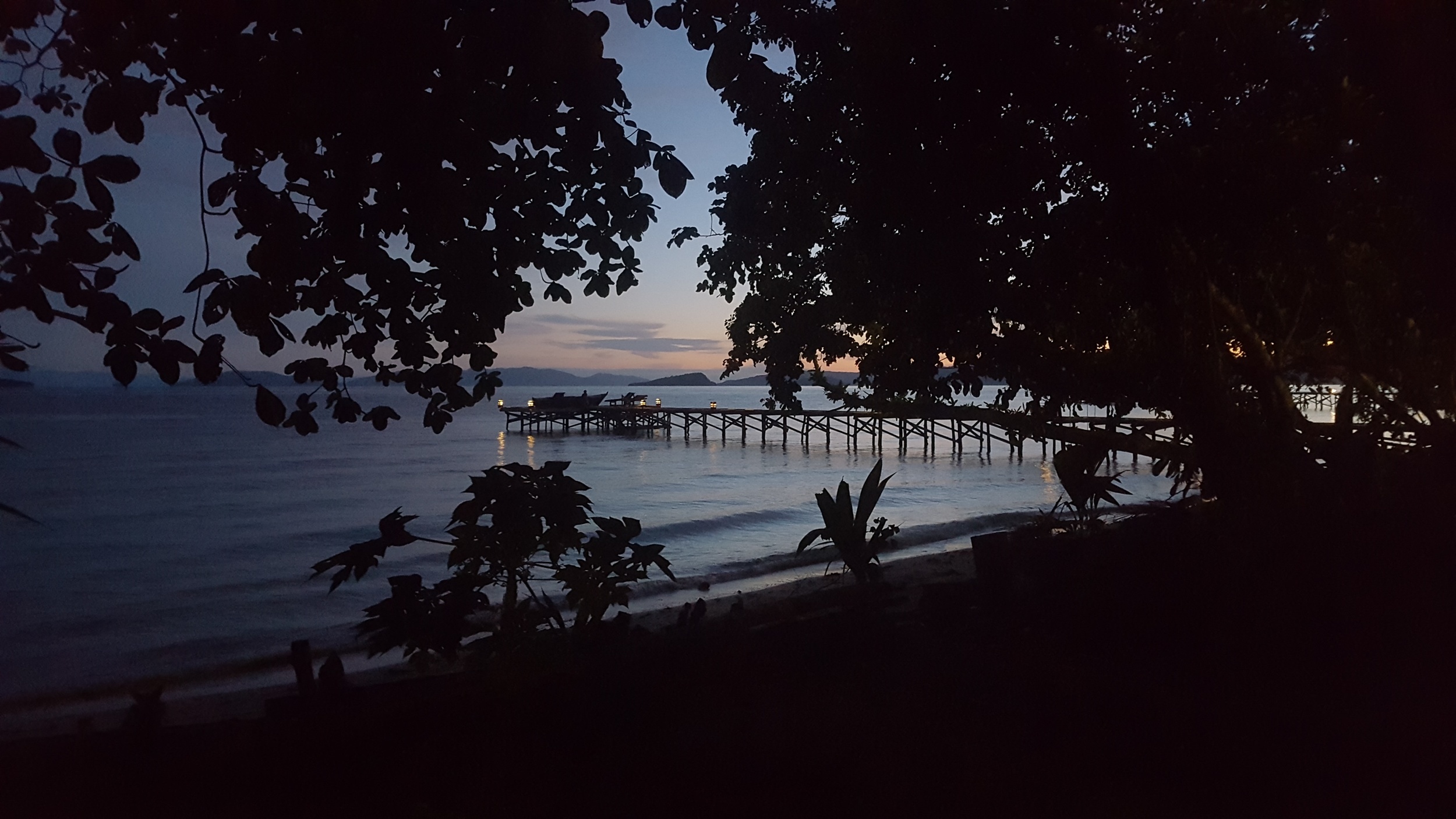
Day 20, 31/7/18, “The beginning of the end”
Our penultimate day is mostly a travel day, so not really a lot to report. It starts – like our previous 2 days – with a great breakfast at Raja Ampat Dive Resort. In fact, overall we have eaten amazingly well on this trip, even when at our remotest locations like Lake Habema and at Zeth’s camp in the Arfaks. I had expected to be overdosing on tasteless yams, yet we have had a great diversity of tasty dishes everywhere – a testament to Shita’s planning and the fantastic hospitality and ingenuity of the locals. After brekkie we finalise our packing and board a dive boat for a 25min journey to the port. It’s pretty choppy once we leave the jetty. Our pilot does his best to ride the waves, but misjudges a few and Shita and Benny, sitting windward side, get absolutely soaked.
Our ferry ride back to Sorong is uneventful (and birdless) and we find ourselves back at the Swisshotel eating pizza and drinking beer once more as Shita makes arrangements for our final bit of birding for the trip. We load up cars and head a couple of hours away from Sorong to some nice lowland forest (those two adjectives, “nice” and “lowland” are not often used together to describe forest anywhere in South East Asia in 2018!).
Immediately we find some trip ticks in this new habitat, with Yellow-billed Longbill and Black Cicadabird (both male and female) before setting out on a long walk along a muddy but broad, well defined forest trail. We are not far into this walk when we hear Red-breasted Paradise Kingfisher, arguably the key local specialty. It is distant and doesn’t respond, but a few minutes later one is much closer. Benny is straight onto it and for once I too am both in the right place and on the ball, and I grab great views of the cracker. I am loath to go for camera before the others get on it, but as we are trying to give directions to Steve it flies off. Bugger! It calls from deeper in the forest so we have no choice but to go in. It is still calling, and continues even as we get closer by pushing through the dense vines. It is still a bastard to see – they are not especially skulking, but they just sit still and if the angle is wrong you have no chance. Fortunately Steve is on the case (perhaps concentration focused from his dip 5 minutes ago) and he finds it perched in the open but unobtrusively. We all score great views and decent enough pictures considering how dark the forest is.




We see little to raise the pulse-rate over the next 90 minutes as we walk through the forest until we reach a pretty village in a clearing, where we will be spending the night in fairly basic accommodation tonight. As we enjoy dinner, Ivory-billed Coucal (also known as Great Black) and Hook-billed Kingfishers call, and a pair of Papuan Nightjars flies around the clearing. As we are heading for bed a Papuan Frogmouth calls and later tonight, as I lie awake in bed, I hear the first unequivocal Papuan Hawk-owl of the trip.
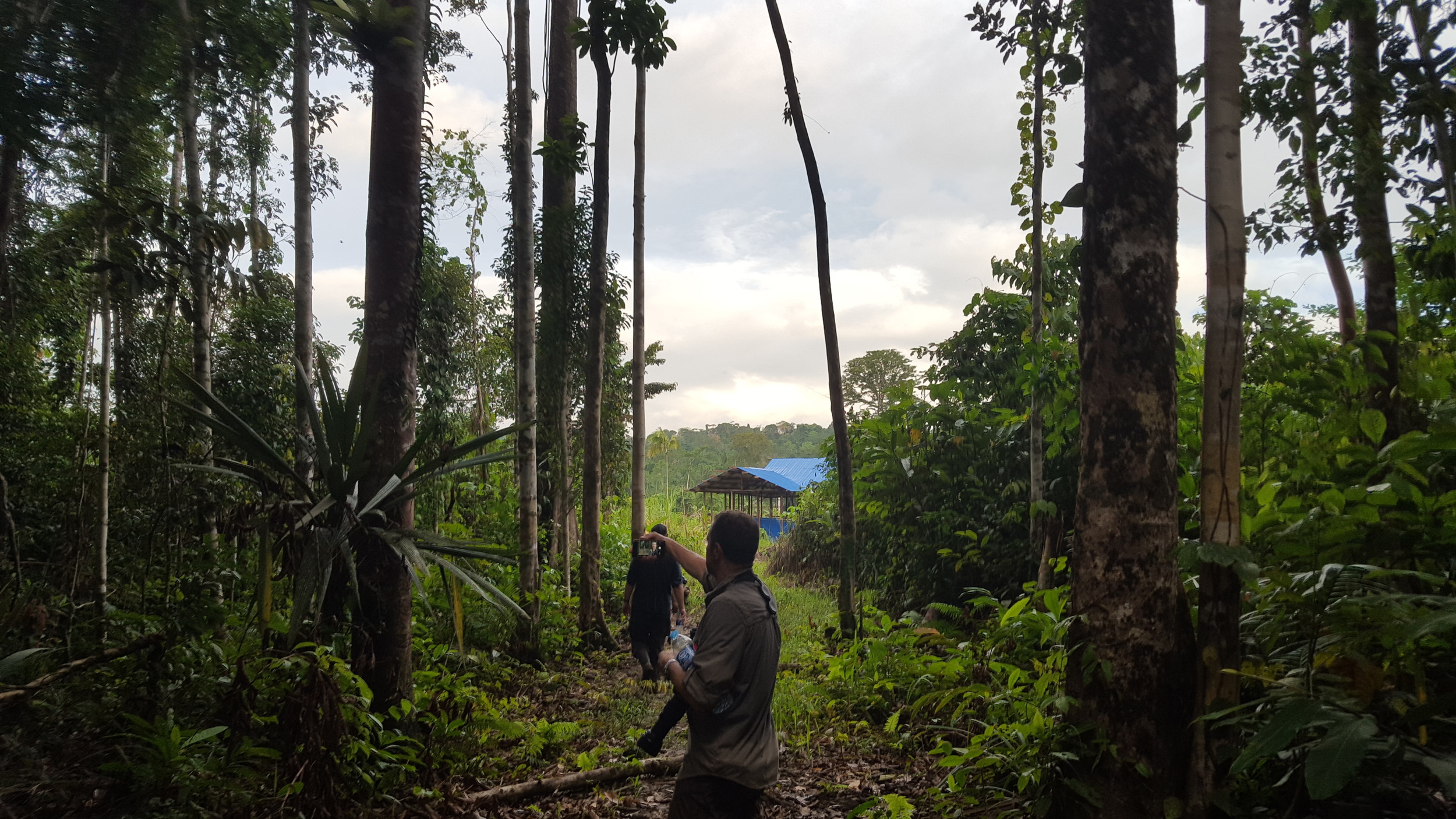
Day 21, 1/8/18, “The End”
Fifteen years after first planning a trip to New Guinea (more than 20 for Steve), and an even decade after actually getting to this amazing island, we have just about come to the end of an amazing trip that has finally delivered the “Full Attenborough”. The highlights reel is extensive, with displaying Twelve-wired, Red BoP, Superb BoP, Black Sicklebill, Western Parotia, Wilson’s BoP and Vogelkop Bowerbird, fabulous encounters with Crowned Pigeons, Paradise Kingfishers and Owlet-nightjars, and throughout great company, laughs and pretty-much flawless logistics. The birding gods have truly smiled on our team for the last 3 weeks. The gods are, however, a fickle bunch and not quite done with us yet. They will punch me in the guts and kick me in the knackers before the morning is out.
After an early breakfast we hang around the village to pick up a few new birds. The main target this morning is Black Lory; several parties of between 2 and a dozen birds shuttle back and forth across the clearing. I manage some deeply underwhelming flight shots, and annoyingly when I observe four land in a palm over my head by the village school-house, my camera is 50m away and the birds have gone by the time I get it. At least this view in bins is more than a flight silhouette of an all-dark bird; they are very smart, black scalloped plumage with a red and golden tail, like a burning ember.
There are dozens of Yellow-faced Myna in the trees at the back of the village, and nearby Benny finds a pair of Large Fig-Parrots. We hear various goodies such as Magnificent Riflebird and Twelve-wired Bird of Paradise in the forest but we will not have time to try for them because we still have a long walk and long drive back to Sorong before an early afternoon flight to Jakarta. We rationalise not going for these birds to ourselves – this morning is really just a bonus that Shita has arranged last-minute to use up the final few hours, so there is no point getting in a tizz about missing stuff. The greatest excitement comes early on as we are finishing breakfast – a young Northern Cassowary appears in the clearing and wanders over towards us. This would be a total mega and an amazing way to end the trip, except that we have already been warned by the villagers that, like Max on Kri Island, they have a pet Cassowary raised from an egg found in the forest. It’s still a surreal and pretty special experience to have this huge bird wandering about us, even if it is “plastic” and not tickable.
We have an early afternoon flight so we have worked out we need to begin our trek back through the forest by about 7.30am to have time for a shower and general re-packing in Sorong. In fact we start the trek a little later than planned, closer to 8am, and Steve and Jon set a cracking pace, perhaps nervous that we have eaten into our buffer time. I hang back – I don’t see a lot of point in going any faster than Shita and Benny, and their familiarity with the local bird calls may well still pull out a few more birds. In fact about half an hour into the walk this comes to pass, when a Yellow-billed Kingfisher calls from almost overhead and Shita is straight on it. I get nice views and some passable record shots. I call out to the others but they are already too far up the track and it is gone before we can fetch them back. It’s not a disaster, because neither needs it other than as a nice trip tick.
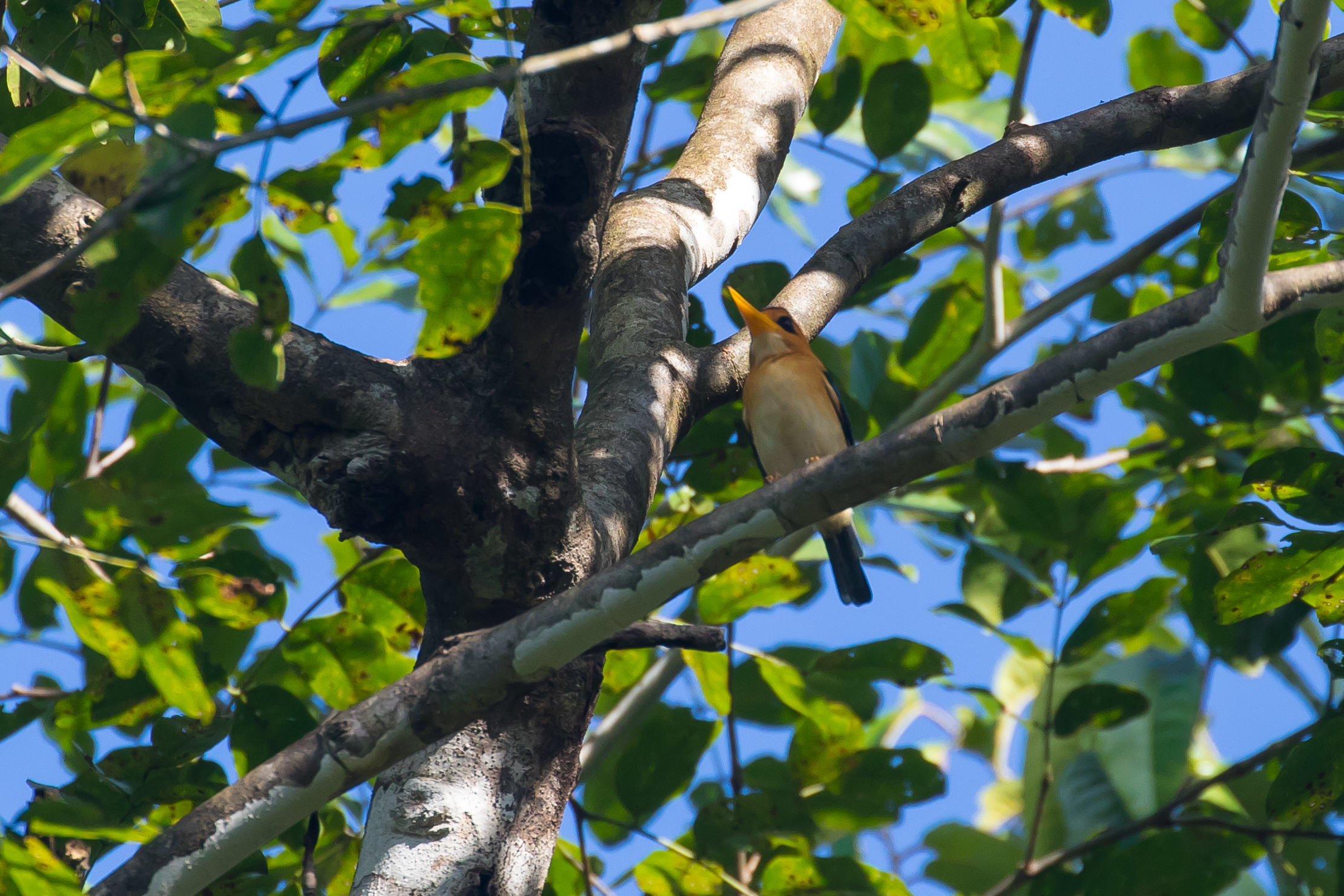
About 10 minutes later we do finally catch up with them. They have stopped rest, or perhaps just realised the futility pf steaming off when they’ll just have to wait at the cars. When we set out again Jon points down at the ground – a fresh set of Cassowary tracks leads off into the forest. It is an omen that I do not heed.
Twenty minutes later we are all pretty-much in non-birding mode, concentrating on getting back to the cars. We are strung out on the trail when suddenly Benny, now at the front of the group, arrests and cries out: “Cassowary! On the track”. He is some 15m ahead of me, and I guess the bird itself is 30-40m further on. Jon, as usual, has the fortune to be in the right place, this time on Benny’s shoulder, and has seen the adult Northern Cassowary walk off the track into the forest. Steve sees the back half of the bird and I hear him says it’s moving off through the forest. Several metres back I can hear the excitement but see nothing.
We rush off in the hope of catching up with it but the forest is dark and dense and it can move much more quickly than us. After 10mins we give up – we have run out of time, but it is probably futile anyway. I feel like I have been punched in the guts and the wind has been taken completely out of me. Steve, who I find out later has seen the back half of the bird but not the head, feels the same. We trudge the remaining 20mins back to the cars numb, and then drive in virtual silence to Sorong.
Maybe I just needed that quiet time, but once showered and packed I’m able to rationalise the unexpected but no less hurtful dip right at end of the trip, and my mood has picked up in time for farewells at the airport. We met Shita and Benny 3 weeks ago as guides and clients, but I am sure we are now parting as friends.
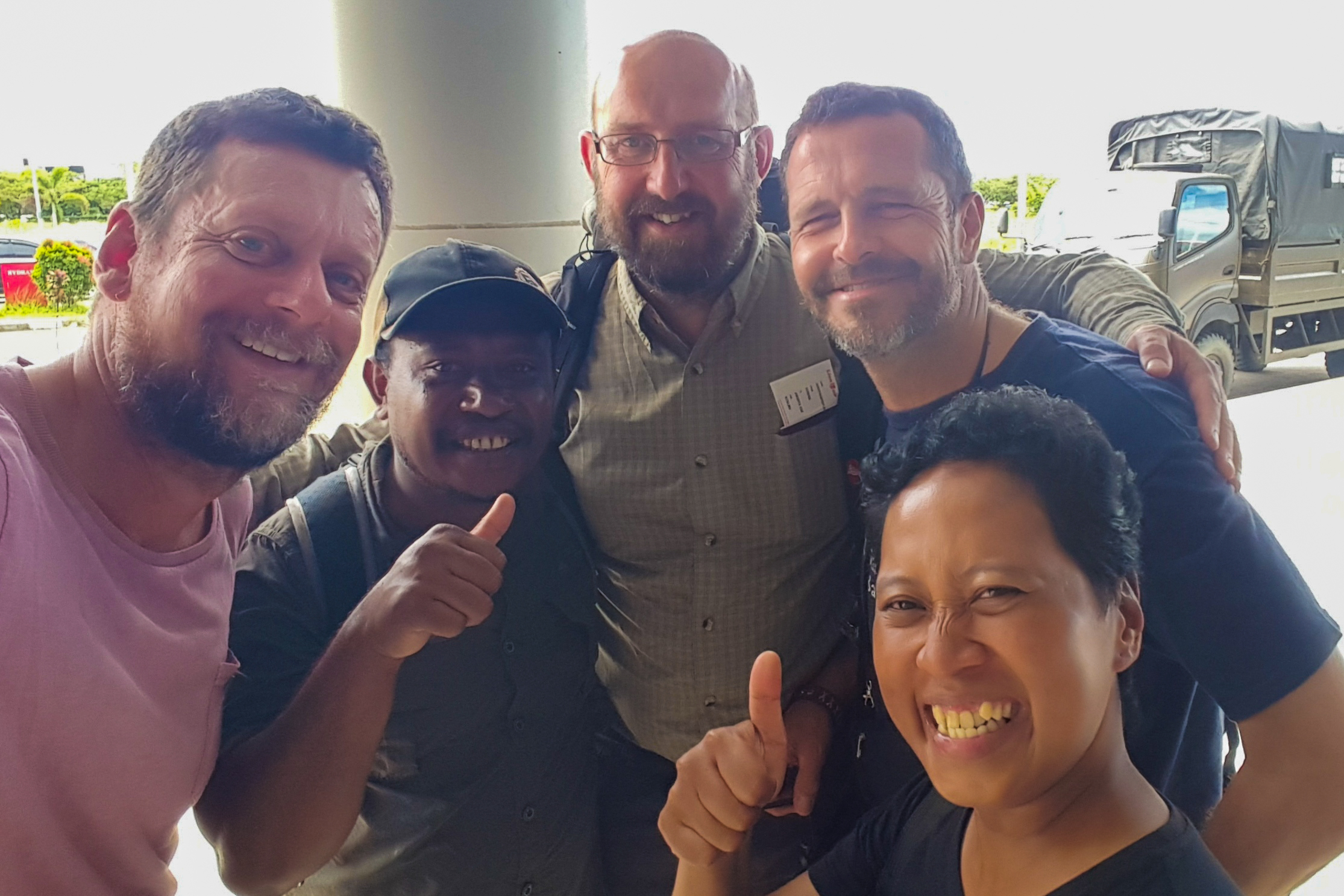
It’s another 5 hours to Jakarta from Sorong, via a stop in Makassar (how tantalising it is to be on the ground in Sulawesi but have no opportunity for birding). We check into the same cheap airport hotel that I used on my way out 3 weeks ago. It might be fun to head downtown, but we find out that it will be an hour and a half by taxi, so 3 hours overall in a car, just for a few beers. Instead we head next door to a slightly more upmarket hotel for a few beers, and then to another even slightly more upmarket hotel where we have our last meal together. After a few drinks before dinner, and more with the meal, nature calls. Steve heads for the gents first and returns with a cryptic message about making sure to get the right room. When the time comes for me too, to break the seal, I wander in the direction of the gents and down the corridor. In front of me I can see a stainless trough along the wall and recognise this as one of those long sports stadium urinals. But then I glance to my right and see some shoes on the ground, and then further over some mats; just in time I realise that the steel on the wall is just decorative, and I have walked not into the toilet but the prayer room. If Islamic law punishes theft by cutting off your hand, I wince at what the punishment for peeing in the prayer room is.
More than a month later, now 15th September, I have just about come to the end of this blog. I almost feel a sense of loss – maybe even more than I felt when saying goodbye to the guys early morning on 2nd August – because I can no longer relive it vicariously through writing about it. I do still have 3000 of my pics and 3500 of Steve’s to get through. It might take me some time…
